Book of the Underworld
We may now pass on to the consideration of the contents of the “Book of 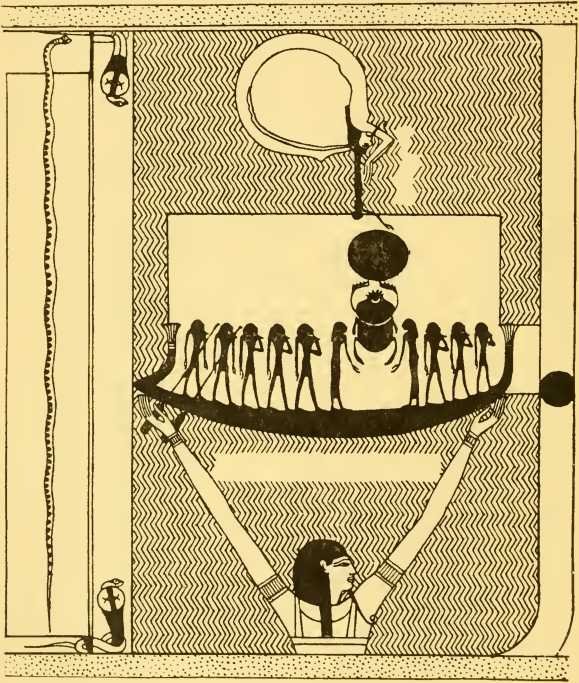 that which is in the Underworld.” The authorities for the text and vignettes of this work are numerous, and from the copies of both which have come down to us it is clear that the book was one of considerable length. But long before the end of the XXIst Dynasty (about B.C. 1100) the Egyptians found it impossible to obtain or to pay for complete copies with all the vignettes, and a shortened form of it consequently came into general use.
that which is in the Underworld.” The authorities for the text and vignettes of this work are numerous, and from the copies of both which have come down to us it is clear that the book was one of considerable length. But long before the end of the XXIst Dynasty (about B.C. 1100) the Egyptians found it impossible to obtain or to pay for complete copies with all the vignettes, and a shortened form of it consequently came into general use.
 that which is in the Underworld.” The authorities for the text and vignettes of this work are numerous, and from the copies of both which have come down to us it is clear that the book was one of considerable length. But long before the end of the XXIst Dynasty (about B.C. 1100) the Egyptians found it impossible to obtain or to pay for complete copies with all the vignettes, and a shortened form of it consequently came into general use.
that which is in the Underworld.” The authorities for the text and vignettes of this work are numerous, and from the copies of both which have come down to us it is clear that the book was one of considerable length. But long before the end of the XXIst Dynasty (about B.C. 1100) the Egyptians found it impossible to obtain or to pay for complete copies with all the vignettes, and a shortened form of it consequently came into general use.
This shortened form, which is called an “Abrégé” by M. Maspero, and a “Résumé” by M. Lefebure, was supposed to contain all that was absolutely necessary for the dead, and it became very popular throughout Egypt.
In the tomb of Seti I. we find a copy of the full text, with vignettes, of the first eleven hours, and also a copy of the “Abridgment.” The space at our disposal will not admit of a detailed description of the longer work, and therefore a notice of the “Abridgment” only is given here. The complete work is entitled, “The beginning of the horn of the West, the remote boundary of thick darkness,” 
 . The “horn of
. The “horn of

 . The “horn of
. The “horn of
the West” means the most westerly point where the sun sets, and keku samu, i.e., “thick darkness,” or “solid darkness,” refers to the extreme end of the Ṭuat, which is painted to resemble a black wall, dotted everywhere with red spots, and which contains an opening through which the boat of Rā emerges every morning. The shorter work is entitled “Abridgment of this book,”  .
.
 .
.First Hour of the Night
image right: The First Hour of the Night.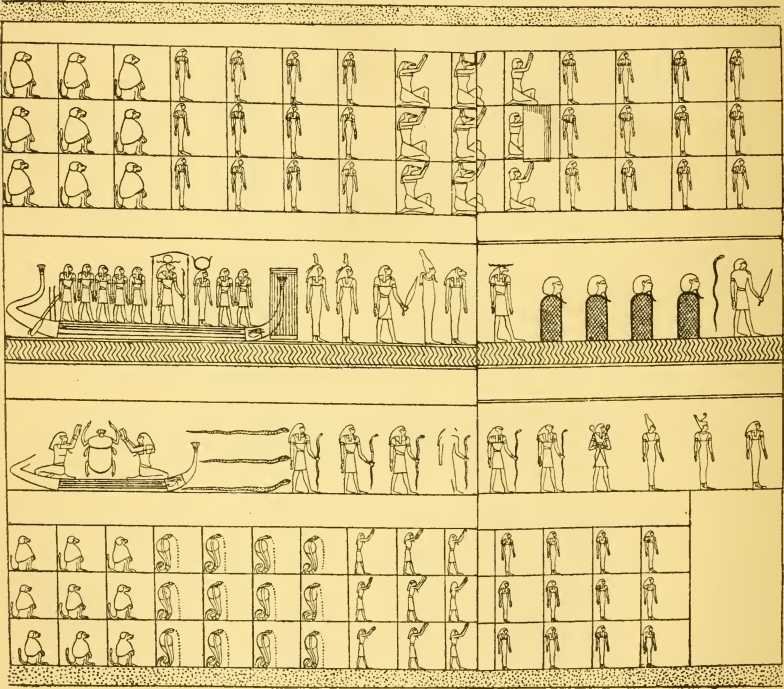

The First Hour of the night is called Ushemet ḥātu khefti Rā, i.e., “Crusher of the forehead of the enemies of Rā,” and the place through which the god passes in it is described as an ārrit,  , i.e., a hall, or a sort of ante-chamber of the Ṭuat. It is quite unlike any part of the Ṭuat, for when Rā is in this hall he has not yet arrived in that dismal valley. But even when here he is an entirely different being from what he was in the day-time, for instead of being the sun of day, he is the sun of night, i.e., a dead god, in fact a mere dead body which is called Ȧf,
, i.e., a hall, or a sort of ante-chamber of the Ṭuat. It is quite unlike any part of the Ṭuat, for when Rā is in this hall he has not yet arrived in that dismal valley. But even when here he is an entirely different being from what he was in the day-time, for instead of being the sun of day, he is the sun of night, i.e., a dead god, in fact a mere dead body which is called Ȧf, , i.e., “Flesh,” and is represented with the head of a ram surmounted by a solar disk.
, i.e., “Flesh,” and is represented with the head of a ram surmounted by a solar disk.
 , i.e., a hall, or a sort of ante-chamber of the Ṭuat. It is quite unlike any part of the Ṭuat, for when Rā is in this hall he has not yet arrived in that dismal valley. But even when here he is an entirely different being from what he was in the day-time, for instead of being the sun of day, he is the sun of night, i.e., a dead god, in fact a mere dead body which is called Ȧf,
, i.e., a hall, or a sort of ante-chamber of the Ṭuat. It is quite unlike any part of the Ṭuat, for when Rā is in this hall he has not yet arrived in that dismal valley. But even when here he is an entirely different being from what he was in the day-time, for instead of being the sun of day, he is the sun of night, i.e., a dead god, in fact a mere dead body which is called Ȧf, , i.e., “Flesh,” and is represented with the head of a ram surmounted by a solar disk.
, i.e., “Flesh,” and is represented with the head of a ram surmounted by a solar disk.
In the day time he travelled in the Āṭet boat,  , but at night he made his journey along the river of the Ṭuat in the Sektet boat,
, but at night he made his journey along the river of the Ṭuat in the Sektet boat, , in fact, in the same boat in which he sailed over the sky from noon to sunset.
, in fact, in the same boat in which he sailed over the sky from noon to sunset.
 , but at night he made his journey along the river of the Ṭuat in the Sektet boat,
, but at night he made his journey along the river of the Ṭuat in the Sektet boat, , in fact, in the same boat in which he sailed over the sky from noon to sunset.
, in fact, in the same boat in which he sailed over the sky from noon to sunset.
In the boat with the dead Sun-god Ȧf are
- Ȧp-uat,
 ,
, - “The Opener of the ways,”
- Sa,
 ,
, - Ḥeru-Ḥekenu,
 ,
, - Nehes,
 ,
, - Ḥu,
 ,
, - the double of Shu,
 ,
, - the captain of the boat,
 ,
, - and the “lady of the boat,”
 .
.
The last-named celestial personage changed every hour, for she represented the local goddess of one hour who was supposed to be the appointed guide of the god through one portion of the Ṭuat only ; knowing the way through her own district, she was able to instruct the captain of the boat how and where to sail over difficult reaches of the river.
The dwellers in the First Hour of the night appear to have been the apes who opened the doors of the ārrit to the god, and the beings who were necessary for the singing of songs of praise to Rā, and for piloting his boat through this hall to the Ṭuat, and a large number of celestial beings who are mentioned in the text, but who are otherwise unknown, and the souls of the dead who had passed from the earth to this intermediate place and who were waiting for the opportunity of entering into the boat of Rā, wherein they would fain continue their journey.
Why the last-named were here cannot be said, but it is probable that such souls belonged to men and women who, when living upon earth, were unable to avail themselves of all the costly and complicated ceremonies prescribed by the priests, and the numerous amulets which were thought to be necessary for the welfare of the soul in the Ṭuat.
The descriptive text of the First Hour reads:—
“This “god entereth from the earth into the ārrit of the horizon of the West, and he must travel one hundred and twenty ȧtru () in this ārrit before he arriveth at the gods of the Ṭuat. Net-Rā (
) is the name of this first country of the Ṭuat. Rā giveth fields to the gods who are in his following, and he beginneth to pass decrees and to give commands concerning the things which are done in the Ṭuat by the gods of this country.
Whosoever shall do these things according to this similitude of the hidden things of the Ṭuat, and shall recognize that they are similitudes of the great god himself, shall find them of benefit to him on the earth, and they shall do him good in the great Ṭuat.”
The fact that this region is called “country” shows that it was regarded almost as a part of this world, and it is definitely stated that it is 120 ȧtru in length; now, the ȧtru is [Page 208] said to be the equivalent of the Greek  , i.e., about an English furlong, and thus the region of the sunset traversed by Rā in his first hour would be fifteen miles in length. It is probable, however, that 120 ȧtru were intended to be a greater distance than fifteen miles, for the second hour brought Rā into the domain of Osiris, which is more than fifteen miles from Thebes.
, i.e., about an English furlong, and thus the region of the sunset traversed by Rā in his first hour would be fifteen miles in length. It is probable, however, that 120 ȧtru were intended to be a greater distance than fifteen miles, for the second hour brought Rā into the domain of Osiris, which is more than fifteen miles from Thebes.
 , i.e., about an English furlong, and thus the region of the sunset traversed by Rā in his first hour would be fifteen miles in length. It is probable, however, that 120 ȧtru were intended to be a greater distance than fifteen miles, for the second hour brought Rā into the domain of Osiris, which is more than fifteen miles from Thebes.
, i.e., about an English furlong, and thus the region of the sunset traversed by Rā in his first hour would be fifteen miles in length. It is probable, however, that 120 ȧtru were intended to be a greater distance than fifteen miles, for the second hour brought Rā into the domain of Osiris, which is more than fifteen miles from Thebes.Second Hour of the Night
image right: The Second Hour of the Night.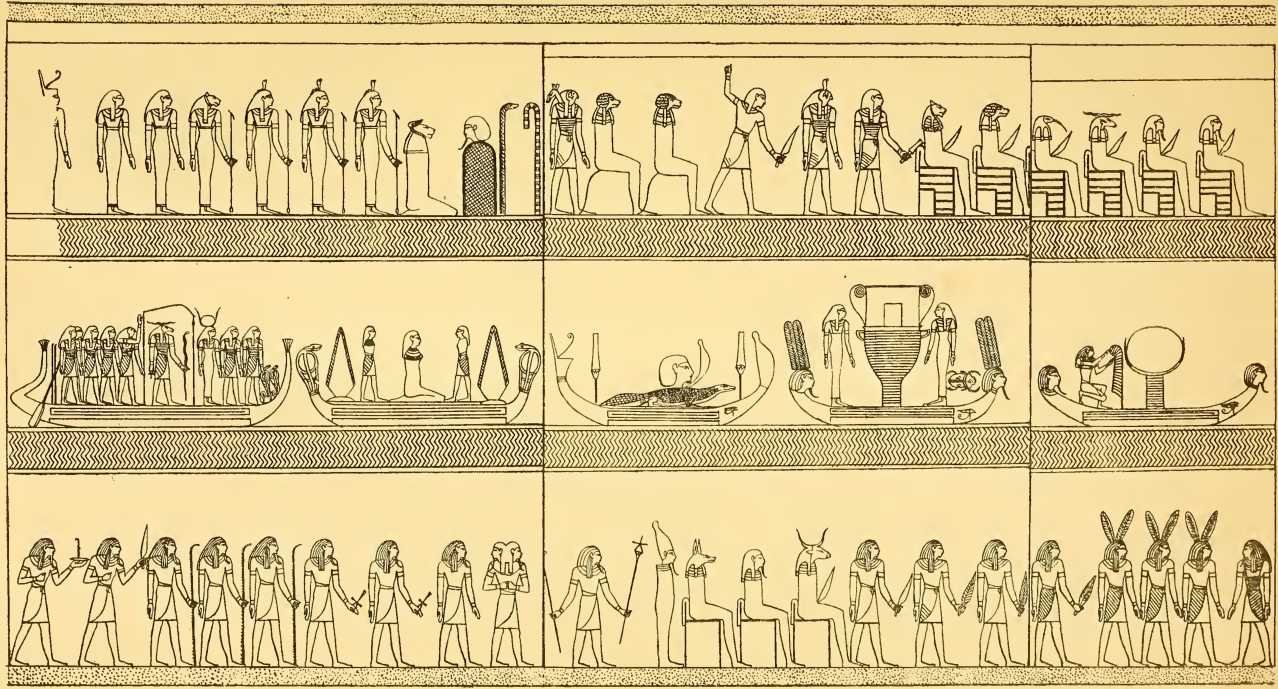

The name of the Second Hour is Shesat māket neb-s, i.e., “She who knoweth how to protect her lord.” The country passed through is called Ur-nes, , which the late Dr. Birch compared with, and believed to be equivalent to, the Greek σχοῖνός; this name, however, seems to be that of the Nile in the second region of the Ṭuat, and in any case it is not applied to any other division or hour except by accident.
, which the late Dr. Birch compared with, and believed to be equivalent to, the Greek σχοῖνός; this name, however, seems to be that of the Nile in the second region of the Ṭuat, and in any case it is not applied to any other division or hour except by accident.
 , which the late Dr. Birch compared with, and believed to be equivalent to, the Greek σχοῖνός; this name, however, seems to be that of the Nile in the second region of the Ṭuat, and in any case it is not applied to any other division or hour except by accident.
, which the late Dr. Birch compared with, and believed to be equivalent to, the Greek σχοῖνός; this name, however, seems to be that of the Nile in the second region of the Ṭuat, and in any case it is not applied to any other division or hour except by accident.
The descriptive text says,
“This great god next arriveth in Ur-nes, which is three hundred and nine ȧtru in length, and one hundred and twenty ȧtru in width (i.e., this division measures about 50 miles by 15 miles). The name of the gods who are in this country is ‘Souls of the Ṭuat,’, and he who knoweth their name shall be with them.
This great god will give to him fields, the situation of which shall be in the country of Ur-nes; he shall stand up with the gods who stand up, and he shall follow after this great god.He shall make his way through the Ṭuat, he shall see the tresses of the gods who wear long flowing hair, he shall trample upon the Eater of the Ass (), and after the division of the unoccupied land hath been made, he shall eat bread in the Boat of the Earth (
), and there shall be given to him of the first things of Tatubȧ (
).”
The text adds that those who draw pictures of these Souls of the Ṭuat and make offerings to them upon earth will gain benefit therefrom a million fold after death; moreover, it will be extremely useful to them in the Ṭuat if they know what words are addressed by the gods to the great god.
The gods with long flowing hair are the four children of Horus, Mesthȧ, Ḥāpi, Ṭuamutef and Qebḥsennuf, each of whom wore a lock or tress of hair, which became a pillar-sceptre, and supported one of the four corners of heaven ; these four gods became at a later period the gods of the cardinal points and the lords of the four quarters of heaven.
The Eater of the Ass is, of course, the great serpent of darkness, probably Āpepi, and the Ass is a form of the Sun-god, between whom and the serpent was continual Avar ; the Ass was connected with the Sun-god by reason of his great virile powers. According to M. Maspero,1 the Boat of the Earth is a name given to the Boat of Rā when it reaches the earth ; Tatubȧ was probably an earth god.
The illustrated version of the Second Hour shows that the boat of Rā was preceded by four boats.
1) The first of these had a human head on each end, and on its side were the picture of heaven, , and the Utchat,
, and the Utchat, . In the boat rests the moon on a pedestal, and behind it is the god who sets up the feather of Maāt. This is the boat of Osiris as the Moon, who is one of the Souls of the Ṭuat.
. In the boat rests the moon on a pedestal, and behind it is the god who sets up the feather of Maāt. This is the boat of Osiris as the Moon, who is one of the Souls of the Ṭuat.
 , and the Utchat,
, and the Utchat, . In the boat rests the moon on a pedestal, and behind it is the god who sets up the feather of Maāt. This is the boat of Osiris as the Moon, who is one of the Souls of the Ṭuat.
. In the boat rests the moon on a pedestal, and behind it is the god who sets up the feather of Maāt. This is the boat of Osiris as the Moon, who is one of the Souls of the Ṭuat.
2) The second boat has a human head surmounted by the plumes of Ȧmen, , on each end, and in it is a huge sistrum, the emblem of Hathor; on each side of it is a goddess. In the bows is a beetle,
, on each end, and in it is a huge sistrum, the emblem of Hathor; on each side of it is a goddess. In the bows is a beetle, . This is the boat of Isis as Hathor, who is one of the Souls of the Ṭuat.
. This is the boat of Isis as Hathor, who is one of the Souls of the Ṭuat.
 , on each end, and in it is a huge sistrum, the emblem of Hathor; on each side of it is a goddess. In the bows is a beetle,
, on each end, and in it is a huge sistrum, the emblem of Hathor; on each side of it is a goddess. In the bows is a beetle, . This is the boat of Isis as Hathor, who is one of the Souls of the Ṭuat.
. This is the boat of Isis as Hathor, who is one of the Souls of the Ṭuat.
3) The third boat has the white crown at the bows, and the red crown at the stern ; in it, between the two standards, which are the symbols of the gods Anpu (Anubis) and Ȧpuat, is a huge lizard, out of the back of which spring a human head and the white crown. This is the boat of the god who opens the ways, and who is one of the Souls of the Ṭuat.
4) The fourth boat has a uraeus at the bows and stern. In the centre is a kneeling woman without arms, and on each side of her stands a woman also armless ; at each end of the boat is a plant, or shrub. This is the boat of Nepr, , the god of grain and of vegetation, and a form of Osiris, and he is also one of the Souls of the Ṭuat.
, the god of grain and of vegetation, and a form of Osiris, and he is also one of the Souls of the Ṭuat.
 , the god of grain and of vegetation, and a form of Osiris, and he is also one of the Souls of the Ṭuat.
, the god of grain and of vegetation, and a form of Osiris, and he is also one of the Souls of the Ṭuat.
The gods who minister to Osiris in the Second Hour are:—
- Isis who avengeth,
 ,
, - Seb of the two corners,
 ,
, - Khnemu of the two corners,
 ,
, - Thoth on his stairs,
 ,
, - Ȧfu on his stairs,
 ,
, - Ketuit-ṭen-ba,
 ,
, - Kherp-ḥu-khefti,
 ,
, - Ḥeru-Ṭuat,
 ,
, - Seben-ḥesq-khaibit,

 ,
, - the two ape-gods Benth,
 , and Ȧānā,
, and Ȧānā,  ,
, - the god with two faces,
 ,
, - Horus-Set, Mest-en-Ȧsȧr,

- Meṭ-en-Ȧsȧr,
 ,
, - the term of Osiris,
- and a lion-headed goddess Sesenet-khu,
 .
.
Behind all these come seven goddesses,
- Mest-tcheses,
 ,
, - Āmām-mitu,

 ,
, - Her-ṭuaiu,
 ,
, - Sekhet of Thebes,
 ,
, - Āmet-tcheru,
 ,
, - Ament-nefert,
 ,
, - and Nit-ṭep-Ament,
 .
.
On the other side of the boat of the god are
- Nebui,
 ,
, - Besabes-uāa,

 ,
, - Nepr,
 ,
, - Ṭepu,
 ,
, - Ḥetch-ā,
 ,
, - Āb,
 ,
, - Nepen,
 ,
, - Ār-ȧst-neter,
 ,
, - Āmu-āa,
 ,
, - Ḥeru-khabit,
 ,
, - Anubis,
- Osiris-Unnefer,
- Khui,
 ,
, - Horus of the two faces, i.e., Horus and Set,
- Ḥen-Ḥeru,
 ,
, - Ḥun,
 ,
, - Ḥatchetchu,
 ,
, - Neḥr,
 ,
, - Makhi,
 ,
, - Renpti,
 ,
, - Āfau,
 ,
, - and Fa-trȧu,
 .
.
All these gods worship the great god, and guide him on his way, and weep when he has left them; some of them bear to him the prayers of those who are upon earth, and also lead disembodied souls to the forms which belong to them; others apparently mark the seasons of the year.
When Rā addressed the beings there, they came to life at the sound of his voice, and they breathed again ; he gave them food in abundance, and the gods gave water to the spirits to drink at his command, and the hearts of the rebels of Rā were burnt in the fire. It is, however, clear from the texts that although Osiris was the Lord of the Second Hour Rā was the overlord of Osiris, and that it was he who, like Osiris, made gifts to the dead.
On the other hand, the followers of Osiris had to perform service for Rā, and one of their chief duties consisted in keeping in check his enemies, who were always attempting to prevent the progress of his boat; in a way the service of these followers was unrewarded, for they were condemned to remain always in the same place, and to perform the same duty.
From the above paragraph the reader will gain some idea of the difference between the illustrated version of the Second Hour and the abstract of it which is found in the “Abridgment.” As the short version makes no attempt to supply the souls which were supposed to make use of it with the names of the various gods and beings in it, we can only assume that they learnt them when on earth in the body.
The larger version of the Second Hour is extremely interesting in showing what a subordinate place the priests of Ȧmen-Rā made Osiris occupy in respect of Rā when passing through the Ṭuat.
Fourth Hour of the Night
image right: The Third Hour of the Night.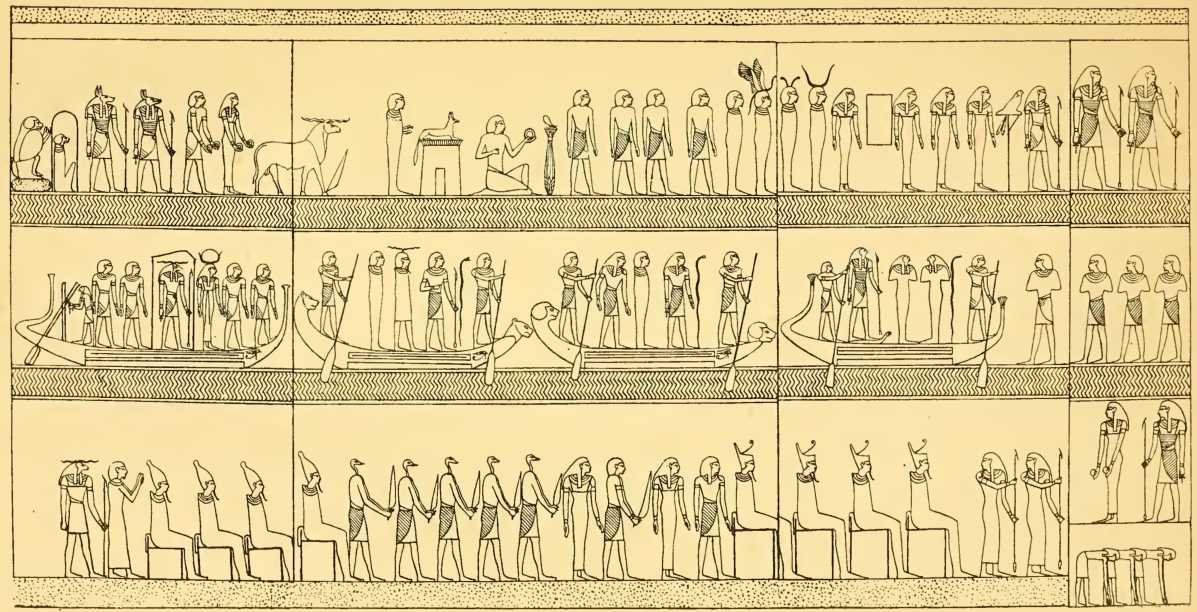

The descriptive text of the Third Hour, which is called Ṭent-baiu, says :—
“This great god next arrives in the Country of those who slay (), and he roweth over the Stream of Osiris (
), a space three hundred and nine ȧtru long, and one hundred and twenty ȧtru wide (i.e., this portion of the Tuat measured about 38½ miles long by 15 miles wide).
This great god giveth commands to the gods who are in the following of Osiris concerning this city, and he assigns to them estates from this country.The name of the gods who are in this field is ‘Hidden Souls’ (), and whosoever knoweth their name shall ascend to the place where Osiris is, and water shall be given unto him for his Field.
The name of this Field is Net-neb-uā-kheper-āutu ().
Whosoever shall make drawings of these Hidden Souls together with a representation of the hidden things of the Ṭuat—beginning the same from the West—it shall be of great benefit not only to him upon earth, but in the Underworld, and indeed always.Whosoever knoweth them shall pass [unhurt] by them as they roar, and shall not fall into their cauldrons.Whosoever knoweth these things, being attached to his place, shall have his bread with Rā.Whosoever, being a soul and a spirit, knoweth these things shall have the mastery over his legs, and he shall never enter into the place of destruction, and he shall come forth in his forms and smell the air at his appointed hour.”
The illustrated version of the Third Hour represents the boat of Rā sailing over the “Stream of Osiris” preceded by three boats, each of which is moved onwards by two men with paddles ; the beings in these boats are all forms of the god Osiris, and the gods who stand on each side of the stream belong to his cycle, or company.
These latter had their bodies of flesh, to which their shadows had been re-united, and their souls talked in them, as soon as Rā had spoken to them; they made answer to the god, and sang his praise whilst he was with them, but their cries of joy changed to lamentations when he left them. They could not go with him, because it was their duty to guard their district, and to destroy the enemies of Rā, and to support the life of Rā, and to make the Nile to flow.
Among the gods in this Hour were the nine forms of the god Osiris:—
- Osiris, lord of Ament,
 ;
; - Khenti-Ȧment,
 ;
; - Osiris the Throne,
 ;
; - Osiris, conqueror of millions,
 ;
; - Osiris the double of Ament,
 ;
; - Osiris on his staircase,
 ;
; - Osiris prince of the gods,
 ;
; - Osiris king of Lower Egypt,
 ;
; - and Osiris-Saḥu,
 .
.
The duties of the beings who are grouped with these are clear from their names, for these refer to destruction in one form or another, and the explanatory text tells us that they are employed in
“hacking and cutting souls, in shutting up the shadows of the dead, and in dragging the occupants of tombs to their place of slaughter;”
moreover, they shoot out flames, they cause fires to come into being, and the heads of the enemies of Rā are cut off by their swords. The master of the region traversed in the Third Hour is called Khatrȧ, , and we learn from the speech of Rā that the inhabitants of the mythological district over which he presides were created by Rā specially to follow and to protect Osiris.
, and we learn from the speech of Rā that the inhabitants of the mythological district over which he presides were created by Rā specially to follow and to protect Osiris.
 , and we learn from the speech of Rā that the inhabitants of the mythological district over which he presides were created by Rā specially to follow and to protect Osiris.
, and we learn from the speech of Rā that the inhabitants of the mythological district over which he presides were created by Rā specially to follow and to protect Osiris.
To these he says,
“O ye whom I have hidden,
whose souls I have put in a secret place,
whom I have set in the following of Osiris to defend him; to accompany his images,
to make an end of those who attack him
(even as the god Hu is behind thee, O Osiris,
to defend thee, to accompany thy images,
to destroy those who attack thee, even as Hu is to thee, O Osiris,
and even as Sa is to thee, O Khenti Ȧmentet),
ye souls whose forms are stablished,
ye souls whose magical powers make certain your coming into being,
who breathe the air [through your nostrils, who look] with your faces,
who listen with your ears,
who are apparelled in your raiment,
who are clothed with your swathings,
who have offerings made to you at stated seasons by the priests of God,
who have estates set apart for your own behoof and benefit,
whose souls are not cast down,
whose bodies are not overthrown: [O Hidden Souls, I say] open ye your circles,
and set ye yourselves in your own places,
for I have come to see my bodies,
and to look upon the similitudes of myself which are in the Ṭuat,
and it is you who have brought me along and have given me the opportunity of coming to them.And now I lead thy soul to heaven, O Osiris, and thy soul to earth, O Khenti Ȧuḳert, with thy gods behind thee, and thy spirits before thee, and thy being and thy forms [about thee].And thy spirit hath its word of power, O Osiris, and you, ye spirits who are in the following of Osiris, have your words of power.I go up on the earth and the day is behind me; I pass through the night,
and my soul rejoins itself to your forms during the day,
and I fulfil the ceremonies of the night which are needful for you.I have created your souls for mine own use,
so that they may be behind me,
and what I have done for them will preserve you from falling down to the place of destruction.”
image right: The Fourth Hour of the Night.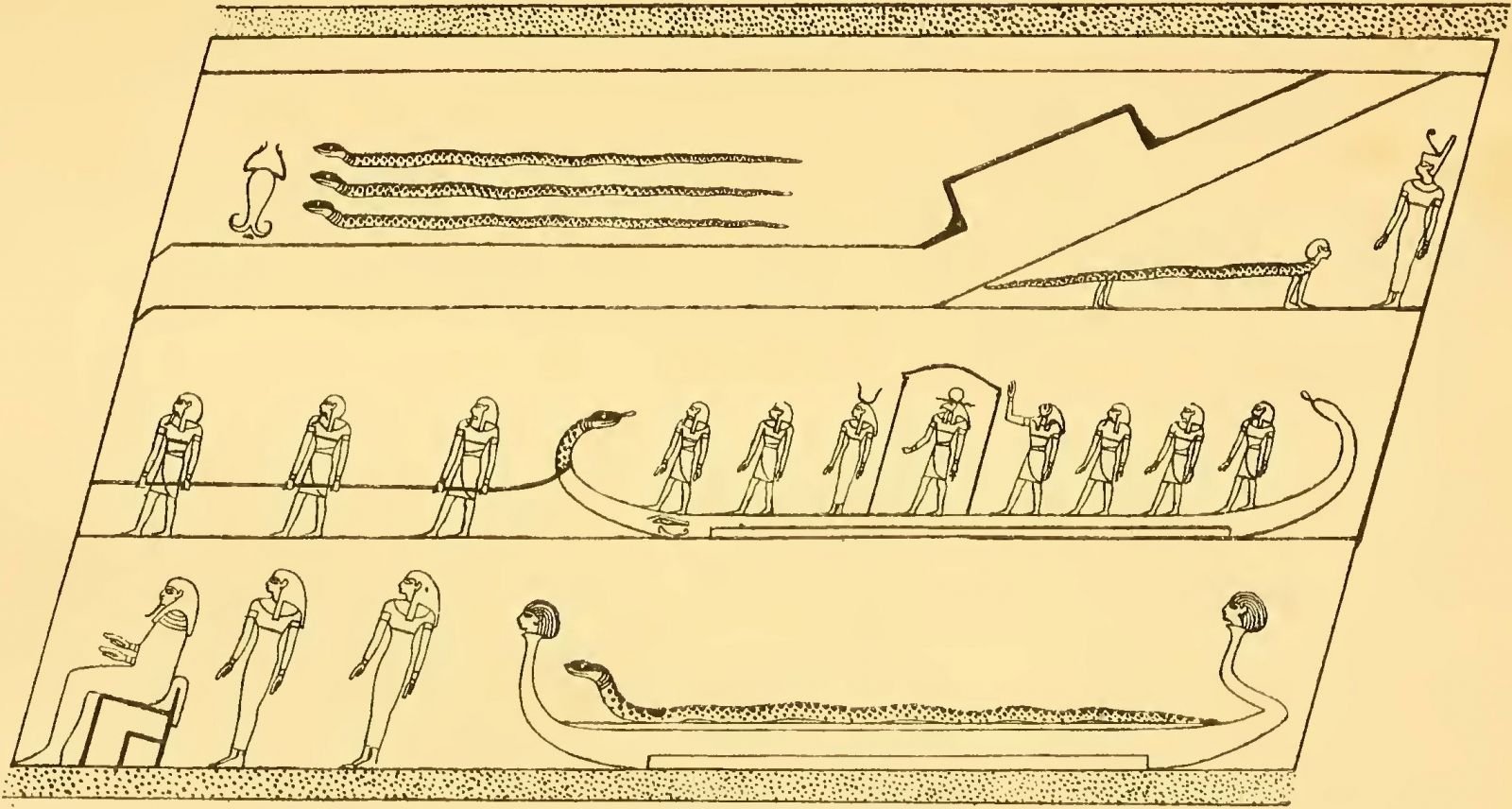

The Fourth Hour of the night, which is called Sekhemus conducts the boat of the Sun-god through a region of a very different character from the earlier divisions. The descriptive text says,
“The majestv of this great god next arriveth in the hidden Circle of Amentet, and lie performeth the designs of the gods who are therein by means of his voice without seeing them.The name of this Circle is Ānkhet-kheperu (), and the name of the pylon of this Circle is Ȧment-sthau (
).
Whosoever knoweth this plan of the hidden paths of Re-stau () , and of the winding roads of the Ȧmmeḥet (
) , and of the hidden pylons which are in the Land of Seker, he who is on his sand shall eat the bread which hath been prepared for the mouth of the living gods who are in the temple of Tem.
He who knoweth these things shall [know] the paths rightly, and shall have power to journey along the roads of Re-stau, and to see the forms (or guides) in the Ȧmmeḥet.”
The Circle Ȧmmeḥet is, as we learn from Chapter cxlix of the Book of the Dead, the Sixth Ȧat, or district of the domain of Osiris which is presided over by the god Seker; the deceased addresses it thus:—
“Hail, thou Ȧmmeḥet which art holy unto the gods,
and art hidden for the spirits,
and art baleful unto the dead;
the name of the god who dwelleth in thee is Sekher-Āṭ (?) [or Sekher-remu].Homage to thee, O Ȧmmeḥet,
I have come to see the gods who dwell in thee.Uncover your faces and put off your head-dresses when ye meet me,
for, behold, I am a mighty god among you,
and I have come to prepare provisions for you.Let not Sekher-Āṭ(?) have dominion over me,
let not the divine slaughterers come after me,
let not the murderous fiends come after me,
but let me live upon sepulchral offerings among you.” 1
image right: The Fourth Hour of the Night.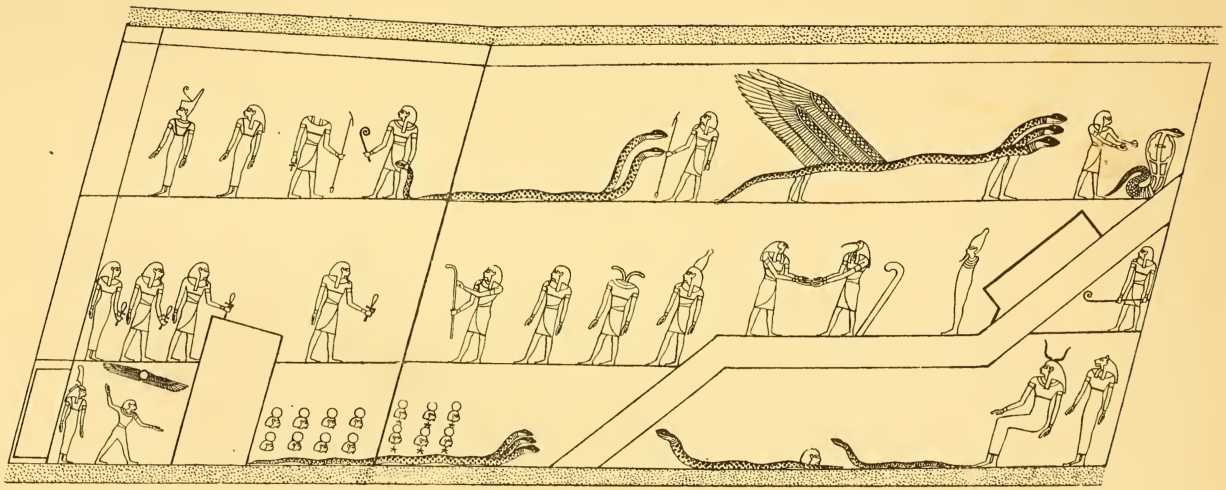

The illustrated edition of the Fourth Hour shows us the boat of Rā passing through an entirely new country, in fact a region which is filled with huge and fearsome snakes, and represents the region over which the god Seker presides.
Here there is no river with banks lined with the gods and the souls of the dead, and here there are no fields to be distributed by Rā among the faithful followers of himself and of Osiris ; indeed there are so few beings to render him service that he is obliged to betake himself to another kind of boat, and the god of day is compelled to glide through the passages of the dark and gloomy land almost without a following of gods.
Rā stands within a shrine in his boat as before, but the boat itself is formed of a serpent with a head at each end of his body ; this boat is hauled over the sandy ground of the god “who is upon his sand” by gods of the company of Osiris, with whom, however, are mingled the gods of the company of Ptah of Memphis, and Osiris himself is merged in Seker and becomes Osiris Seker.
The narrow way, or road, of Re-stau has three doors, which are called
- Māṭes-sma-ta,
 ,
, - Meṭes-mau-āt,
 ,
, - and Meṭes-neḥeḥ,

 ,
,
and by these it is divided into three parts. Into one part the god Rā neither enters nor travels, but the door thereof obeys his voice ; in another part is the body of Seker, who is on his sand, the hidden form which can be neither looked at nor seen ; another part is that through which Seker passeth, but neither the gods, nor the spirits, nor the dead go through it, and it is filled with the souls which have been consumed by the fire that comes forth from the mouth of the goddess Ām-mit. The region through which the boat of Rā travels is full of thick darkness, and the light which the god usually emits is unable to penetrate it; in this difficulty he is helped upon his way by the light of the flames of fire which issue from the mouth of the serpent which forms the body of his boat. Among the gods who march in front of the boat are Thoth and Horus, who stand facing each other with outstretched hands in which they hold an Utchat, , which is here to be identified with the god Seker. The serpents which are passed by the god are of various kinds and of different sizes.
, which is here to be identified with the god Seker. The serpents which are passed by the god are of various kinds and of different sizes.
 , which is here to be identified with the god Seker. The serpents which are passed by the god are of various kinds and of different sizes.
, which is here to be identified with the god Seker. The serpents which are passed by the god are of various kinds and of different sizes.- The first, called Ḥetch-nāu,
 , lies at full length in a boat, each end of which terminates in a human head, and is the guardian of Seker;
, lies at full length in a boat, each end of which terminates in a human head, and is the guardian of Seker; - the second is three-headed, and he moves over the ground on four human legs and feet;
- the third is called Ȧmen,
 ;
; - the fourth is Hekent,
 , and has a human head growing out of its body just above the tail;
, and has a human head growing out of its body just above the tail; - and the fifth is Menmenu,
 , which has three heads, and bears on its back fourteen stars and fourteen human heads surmounted bydisks.
, which has three heads, and bears on its back fourteen stars and fourteen human heads surmounted bydisks.
Next we have three huge serpents near the great scorpion Ankhet,  , and a huge uraeus, to which libations are being poured out by a man ; and a three-headed serpent, with wings, which moves along on four human feet and legs ; and the serpent Neḥeb-kau,
, and a huge uraeus, to which libations are being poured out by a man ; and a three-headed serpent, with wings, which moves along on four human feet and legs ; and the serpent Neḥeb-kau,  , which has two heads at one end of its body, and one head at the other. All these monsters are said to make their journey daily round about the region of the Fourth Hour, and they live upon what they find on their way.
, which has two heads at one end of its body, and one head at the other. All these monsters are said to make their journey daily round about the region of the Fourth Hour, and they live upon what they find on their way.
 , and a huge uraeus, to which libations are being poured out by a man ; and a three-headed serpent, with wings, which moves along on four human feet and legs ; and the serpent Neḥeb-kau,
, and a huge uraeus, to which libations are being poured out by a man ; and a three-headed serpent, with wings, which moves along on four human feet and legs ; and the serpent Neḥeb-kau,  , which has two heads at one end of its body, and one head at the other. All these monsters are said to make their journey daily round about the region of the Fourth Hour, and they live upon what they find on their way.
, which has two heads at one end of its body, and one head at the other. All these monsters are said to make their journey daily round about the region of the Fourth Hour, and they live upon what they find on their way.Fifth Hour of the Night
image right: The Fifth Hour of the Night.

The last hour, as we have seen, is a part of the dominions of Seker, but the Fifth Hour, which is called Semit-ḥer-ȧbt-uȧa-s, contains his capital city.
The descriptive text says,
“This great god is drawn along over the actual roads of the Ṭuat, and over the hidden Circle of Seker, the god who is on his sand, and he neither seeth nor looketh upon the hidden figure of the land which containeth the flesh of this god.The gods who are with this god hear the voice of Rā-Ḥeru (?), and they adore him at the seasons of this god. The name of the pylon of this city is Āḥā-neteru,, and the name of this Circle is Ȧment,
.
[Here are] the secret ways of Ȧment, and the doors of the house of Ȧment, and the habitable house () of the earth of Seker, and his flesh, and his members, and his body, in their primeval forms. The name of those who are in this Circle is ‘Baiu ȧımu Ṭuat’ (i.e., Souls in the Ṭuat). The forms who are in their hours and their hidden beings neither see nor look upon this form of Seker himself.
Whosoever maketh a picture of these things which are in Ȧment in the Ṭuat, to the south of the hidden house, and whosoever knoweth these things, his soul shall be at peace, and he shall be satisfied with the offerings of Seker. And Khemit () shall not hack his body in pieces, and he shall go to her in peace. Whosoever shall make offerings to these gods upon earth shall [find] them of benefit to him in the Ṭuat.”
image right: The Fifth Hour of the Night. 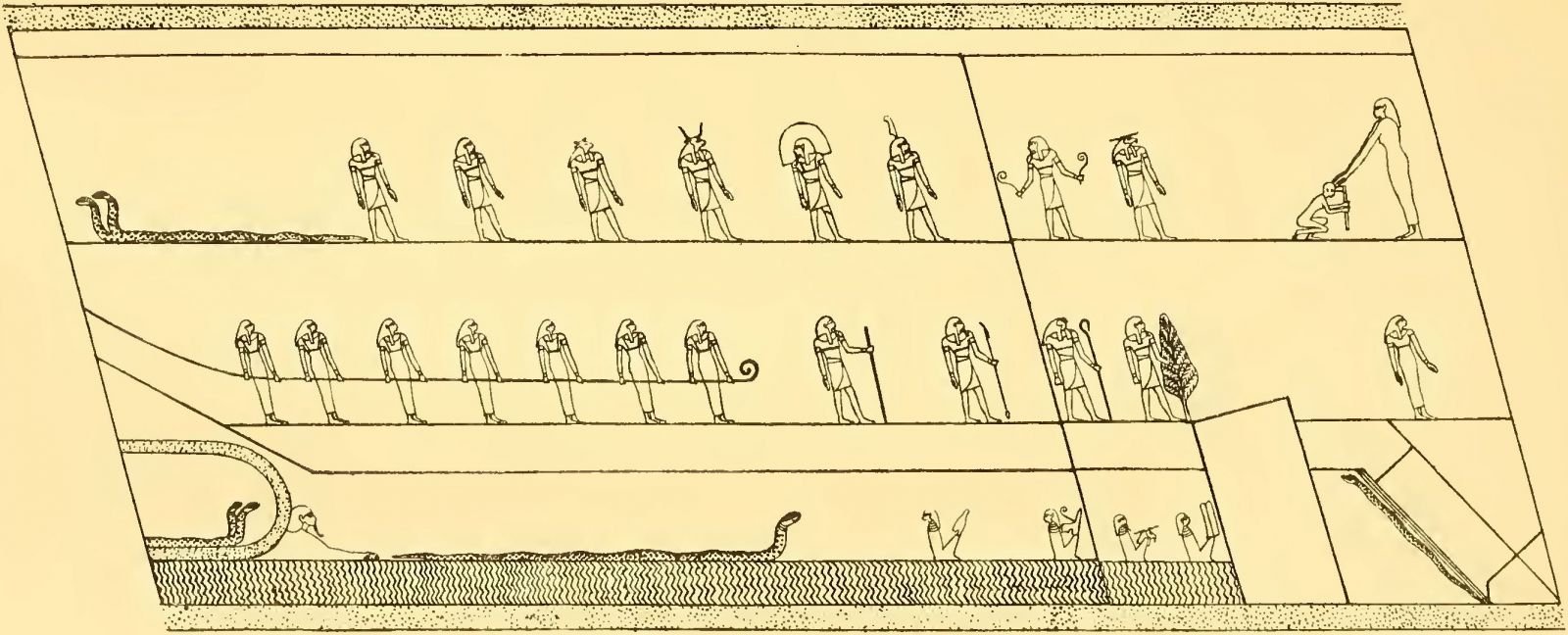

The illustrated version of the Fifth Hour shows us Rā travelling in his serpent boat and being towed along by seven gods and seven goddesses, who represent the gods of fourteen days of the month; before these are the divine sovereign chiefs, i.e.,
- Ḥer-khu,
 ,
, - Ȧn-ḥetep,
 ,
, - Ḥer-ḥequi,
 ,
, - and Ḥetch-met
 .
.
Half way through the hour Rā comes to a mound of sand, the top of which is surmounted by the head of a woman, whereon rests the forepart of a beetle, only one half of which is visible, symbol of the god Kheperȧ; this head indicates the position of the hidden abode wherein is Seker, and when the beetle alights upon it the god Kheperȧ holds converse with that god.
Immediately beneath the head is the “Land of Seker,” which has the shape  , and is described as the “hidden land of Seker which guardeth the hidden flesh;” it is surrounded by a wall of sand, and at each end, outside the wall, is a sphinx with the head of a man and the body of a lion. Inside this land is a two-headed, winged serpent, with a tail which terminates in a human head; between the wings stands a figure of the hawkheaded god Seker; this serpent monster represents the god watching over his own image.
, and is described as the “hidden land of Seker which guardeth the hidden flesh;” it is surrounded by a wall of sand, and at each end, outside the wall, is a sphinx with the head of a man and the body of a lion. Inside this land is a two-headed, winged serpent, with a tail which terminates in a human head; between the wings stands a figure of the hawkheaded god Seker; this serpent monster represents the god watching over his own image.
 , and is described as the “hidden land of Seker which guardeth the hidden flesh;” it is surrounded by a wall of sand, and at each end, outside the wall, is a sphinx with the head of a man and the body of a lion. Inside this land is a two-headed, winged serpent, with a tail which terminates in a human head; between the wings stands a figure of the hawkheaded god Seker; this serpent monster represents the god watching over his own image.
, and is described as the “hidden land of Seker which guardeth the hidden flesh;” it is surrounded by a wall of sand, and at each end, outside the wall, is a sphinx with the head of a man and the body of a lion. Inside this land is a two-headed, winged serpent, with a tail which terminates in a human head; between the wings stands a figure of the hawkheaded god Seker; this serpent monster represents the god watching over his own image.
The two sphinxes are watched by two serpents, Ṭepȧn, , and Ānkh-ȧapau,
, and Ānkh-ȧapau, ; the first serpent enters into the presence of this god, and carries to him daily the offerings which are made by the living, but the second never leaves his place, and lives upon the flames which proceed from his own mouth.
; the first serpent enters into the presence of this god, and carries to him daily the offerings which are made by the living, but the second never leaves his place, and lives upon the flames which proceed from his own mouth.
 , and Ānkh-ȧapau,
, and Ānkh-ȧapau, ; the first serpent enters into the presence of this god, and carries to him daily the offerings which are made by the living, but the second never leaves his place, and lives upon the flames which proceed from his own mouth.
; the first serpent enters into the presence of this god, and carries to him daily the offerings which are made by the living, but the second never leaves his place, and lives upon the flames which proceed from his own mouth.
Before the second serpent are four seated gods, who bear on their knees the emblems of “hidden symbols” of Seker, i.e., , and rest by the side of a lake of water called Nut,
, and rest by the side of a lake of water called Nut, ; for those are in this lake its waters are like fire, and each of the heads of the four gods which rise above them bears upon it the symbol of fire.
; for those are in this lake its waters are like fire, and each of the heads of the four gods which rise above them bears upon it the symbol of fire.
 , and rest by the side of a lake of water called Nut,
, and rest by the side of a lake of water called Nut, ; for those are in this lake its waters are like fire, and each of the heads of the four gods which rise above them bears upon it the symbol of fire.
; for those are in this lake its waters are like fire, and each of the heads of the four gods which rise above them bears upon it the symbol of fire.
The lake is watched over by the company of gods of Rā, represented by nine axes, and five gods. But before Rā has passed through the Fifth Hour he arrives at a large vaulted chamber, filled with sand, and called , i.e., “Night,” and on each side, clinging by its claws, is a hawk; from the lower part of it goes forth the beetle, only one half of which is visible.
, i.e., “Night,” and on each side, clinging by its claws, is a hawk; from the lower part of it goes forth the beetle, only one half of which is visible.
 , i.e., “Night,” and on each side, clinging by its claws, is a hawk; from the lower part of it goes forth the beetle, only one half of which is visible.
, i.e., “Night,” and on each side, clinging by its claws, is a hawk; from the lower part of it goes forth the beetle, only one half of which is visible.
This beetle, or Kheperȧ, typified the germ of life, and when the boat of Rā was drawn on to the top of the mound of sand already described, it was supposed to stop on it as it passed, and having done so, it went to the dead god and raised him up to life.
This chamber was guarded by a two-headed serpent called Ṭer, , and it had to be jealously watched in order to prevent the entrance of any one who would disturb or destroy the germ of life. A little beyond the chamber of sand is a group of seven gods, whose duty it was to inspect the slaughter of the dead in the Ṭuat, and to consume their bodies by the flames of their mouths in the course of each day; and a little further on is the goddess who “lives upon the blood of the dead,” and who is occupied in slaying a man doomed to die by the gods.
, and it had to be jealously watched in order to prevent the entrance of any one who would disturb or destroy the germ of life. A little beyond the chamber of sand is a group of seven gods, whose duty it was to inspect the slaughter of the dead in the Ṭuat, and to consume their bodies by the flames of their mouths in the course of each day; and a little further on is the goddess who “lives upon the blood of the dead,” and who is occupied in slaying a man doomed to die by the gods.
 , and it had to be jealously watched in order to prevent the entrance of any one who would disturb or destroy the germ of life. A little beyond the chamber of sand is a group of seven gods, whose duty it was to inspect the slaughter of the dead in the Ṭuat, and to consume their bodies by the flames of their mouths in the course of each day; and a little further on is the goddess who “lives upon the blood of the dead,” and who is occupied in slaying a man doomed to die by the gods.
, and it had to be jealously watched in order to prevent the entrance of any one who would disturb or destroy the germ of life. A little beyond the chamber of sand is a group of seven gods, whose duty it was to inspect the slaughter of the dead in the Ṭuat, and to consume their bodies by the flames of their mouths in the course of each day; and a little further on is the goddess who “lives upon the blood of the dead,” and who is occupied in slaying a man doomed to die by the gods.
When the boat of Rā arrived at the end of the Fifth Hour he saw the star of the “living god, who journeyeth, and journeyeth and passeth,” . Dr. Brugsch, and following him M. Maspero, and others, have identified this star with the planet Venus, the star of the morning, and the identification is undoubtedly correct.
. Dr. Brugsch, and following him M. Maspero, and others, have identified this star with the planet Venus, the star of the morning, and the identification is undoubtedly correct.
 . Dr. Brugsch, and following him M. Maspero, and others, have identified this star with the planet Venus, the star of the morning, and the identification is undoubtedly correct.
. Dr. Brugsch, and following him M. Maspero, and others, have identified this star with the planet Venus, the star of the morning, and the identification is undoubtedly correct.
This is an important fact, for, as M. Jéquier has pointed out, coupled with the representation of the beetle going forth from the night to place itself in the boat of Rā, it shows us that the domain of Seker, although reduced to two hours which have been inserted in their proper geographical position in the Ṭuat, certainly at one time formed a complete hell, and that the rising of the sun was the final event which took place in it.
Sixth Hour of the Night
image right: The Sixth Hour of the Night.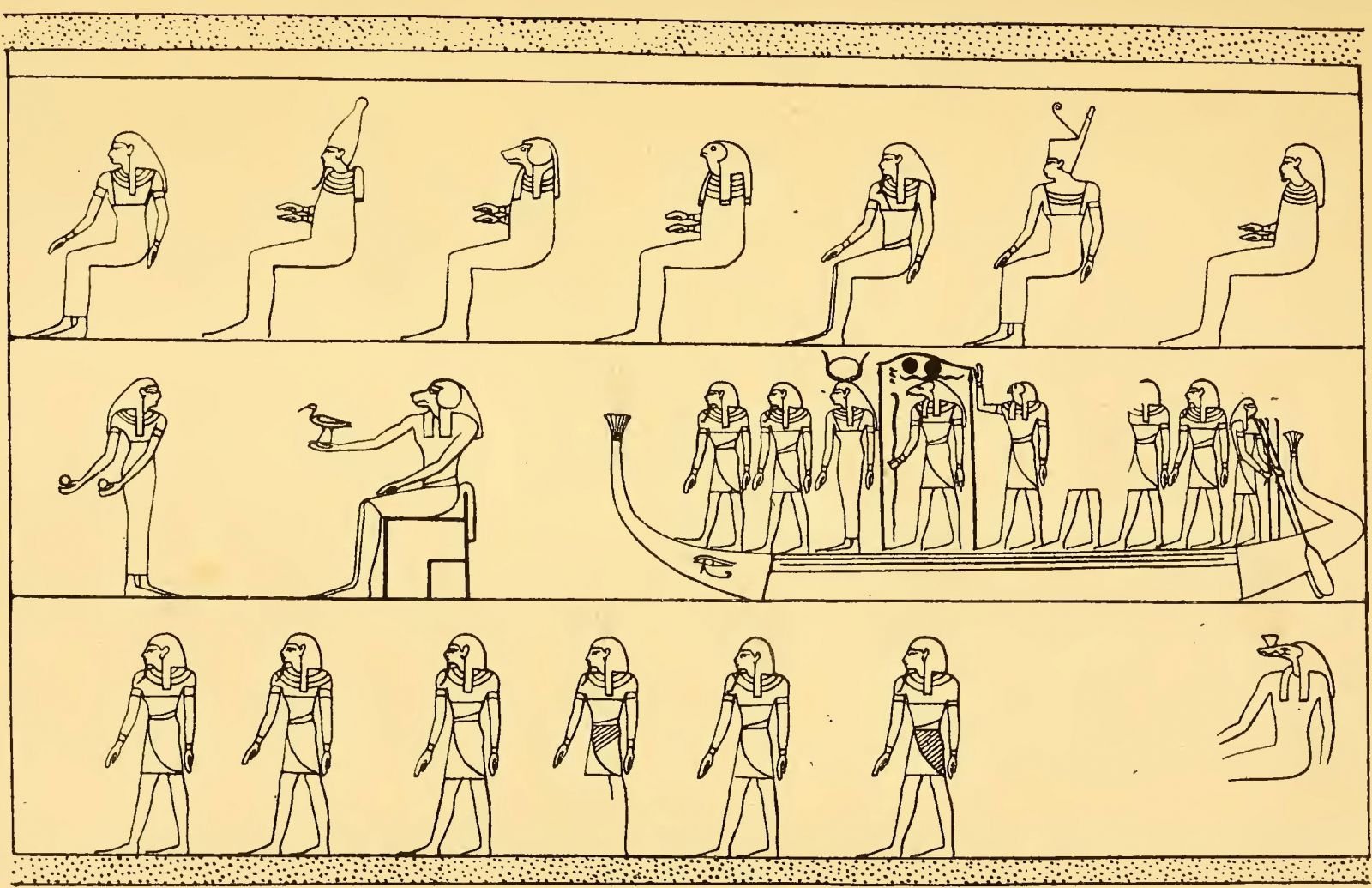

The Sixth Hour, which is called Mesperit-ȧrāt-maātu, brings us to the neighbourhood of the shrines of Osiris in the Delta.
The descriptive text says,
“When this great god arriveth at the abyss of water, which is the lady of the gods of the Ṭuat, he holdeth discourse with the gods who are there, and he giveth the command for them to obtain the mastery over their offerings () in this city.
He saileth in this [Field] being provided with his boat, and he commandeth them [to have] their fields for their offerings, and he giveth them water for their streams as they go about the Ṭuat each day.The name of the pylon of this city is Sepṭ-metu (). The hidden path of Ȧmentet, on the stream of which this great god journeyeth in his boat to perform the affairs of the gods of the Ṭuat, and the collecting of their names, and the manner in which their forms rest, and all that appertaineth to their hidden hours, and the hidden similitude of the Ṭuat, are unknown ....
The majesty of this god uttereth words, and he giveth divine offerings to the gods who are in the Ṭuat, and he standeth near them; they see him, and they have the mastery over their fields and over the gifts which are made to them, and they have their beings through the command which this great god, who is mighty of words, giveth unto them. The name of this district is Metchet-nebt-Ṭuatiu ().”
The third paragraph of the text promises to those who make pictures of the Sixth Hour a participation in the offerings which have been made to the gods in the train of Osiris, and also that offerings shall be made to them by their kinsfolk on earth.
image right: The Sixth Hour of the Night.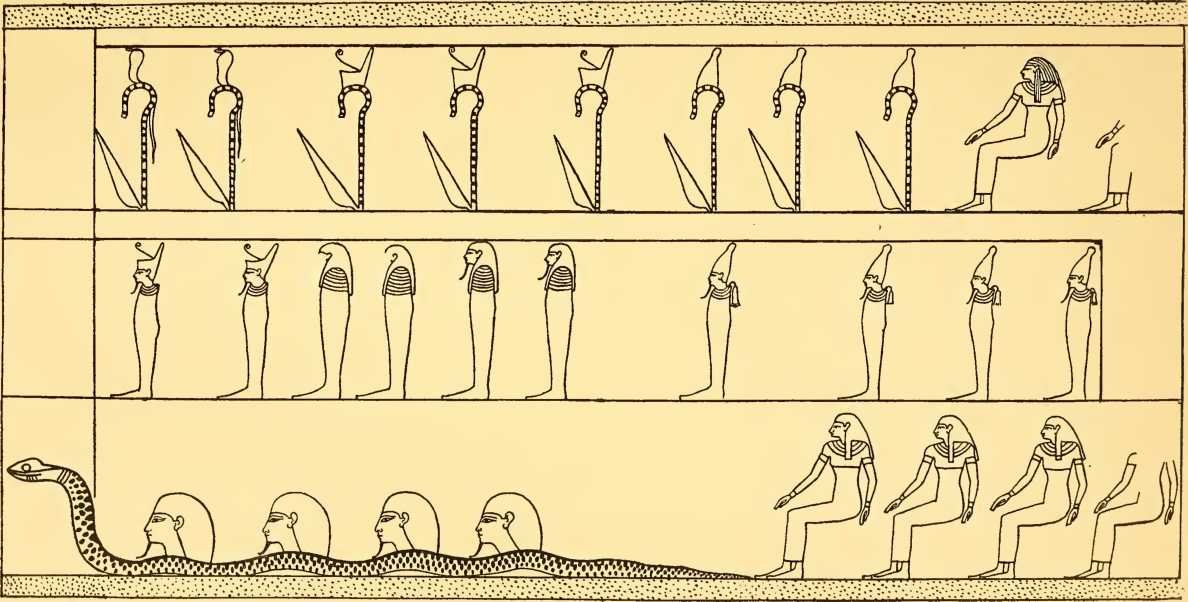

The illustrated edition of the Sixth Hour shows us that Rā has no longer any need of the boat which was made of the body of a serpent wherein he passed through the realm of Seker, and that he is once again in his old boat and sailing over the waters of the stream in the Ṭuat.
In front of his boat are :—
- Thoth, who is called Khenti-Ṭuat, and who is represented by a dog-headed god holding an ibis on his out-stretched right hand;
- and the goddess Ȧment-semu-set,
 .
.
Beyond these is a large house with sixteen divisions, in each of which is a god in mummied form; these represent the mansions of Osiris, and four contain kings of the South, four contain kings of the North, four contain Ḥeteptiu, , and four contain Spirits. All these form the guardians of a huge five-headed serpent called Āsh-ḥrȧu,
, and four contain Spirits. All these form the guardians of a huge five-headed serpent called Āsh-ḥrȧu, , the body of which is bent round into an irregular oval in such a way that his tail almost touches one of his heads. Lying on his back within this oval is a god who is called Āfu,
, the body of which is bent round into an irregular oval in such a way that his tail almost touches one of his heads. Lying on his back within this oval is a god who is called Āfu, , i.e., “Flesh,” and as he is touching with his right hand the leg of a beetle which he holds on his head, we may assume that he represents the dead body of Kheperȧ, and is the opposite of the Sun-god in his boat, who is called “Flesh of Ra,”
, i.e., “Flesh,” and as he is touching with his right hand the leg of a beetle which he holds on his head, we may assume that he represents the dead body of Kheperȧ, and is the opposite of the Sun-god in his boat, who is called “Flesh of Ra,” . The sixteen gods mentioned above are addressed by Rā, who commands them to be happy with their offerings, and to protect him, and to slay the serpent Āpepi; they hearken to his voice, and the text goes on to say that it is the voice of Rā which will make the god within the folds of the serpent Āsh-ḥrȧu and the beetle upon his head to move.
. The sixteen gods mentioned above are addressed by Rā, who commands them to be happy with their offerings, and to protect him, and to slay the serpent Āpepi; they hearken to his voice, and the text goes on to say that it is the voice of Rā which will make the god within the folds of the serpent Āsh-ḥrȧu and the beetle upon his head to move.
 , and four contain Spirits. All these form the guardians of a huge five-headed serpent called Āsh-ḥrȧu,
, and four contain Spirits. All these form the guardians of a huge five-headed serpent called Āsh-ḥrȧu, , the body of which is bent round into an irregular oval in such a way that his tail almost touches one of his heads. Lying on his back within this oval is a god who is called Āfu,
, the body of which is bent round into an irregular oval in such a way that his tail almost touches one of his heads. Lying on his back within this oval is a god who is called Āfu, , i.e., “Flesh,” and as he is touching with his right hand the leg of a beetle which he holds on his head, we may assume that he represents the dead body of Kheperȧ, and is the opposite of the Sun-god in his boat, who is called “Flesh of Ra,”
, i.e., “Flesh,” and as he is touching with his right hand the leg of a beetle which he holds on his head, we may assume that he represents the dead body of Kheperȧ, and is the opposite of the Sun-god in his boat, who is called “Flesh of Ra,” . The sixteen gods mentioned above are addressed by Rā, who commands them to be happy with their offerings, and to protect him, and to slay the serpent Āpepi; they hearken to his voice, and the text goes on to say that it is the voice of Rā which will make the god within the folds of the serpent Āsh-ḥrȧu and the beetle upon his head to move.
. The sixteen gods mentioned above are addressed by Rā, who commands them to be happy with their offerings, and to protect him, and to slay the serpent Āpepi; they hearken to his voice, and the text goes on to say that it is the voice of Rā which will make the god within the folds of the serpent Āsh-ḥrȧu and the beetle upon his head to move.
image right: The Sixth Hour of the Night.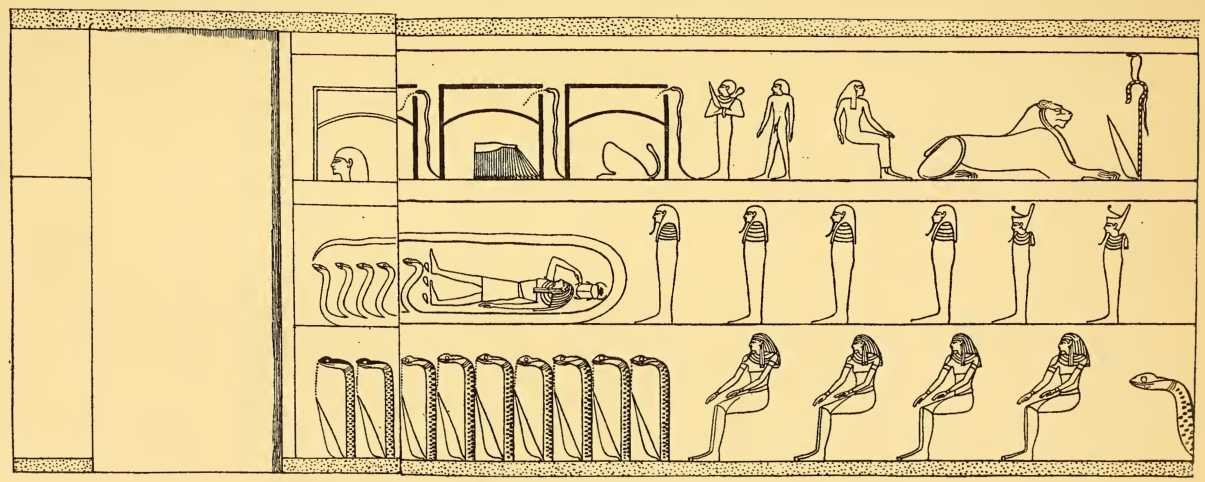

With these must be mentioned the double company of the gods of Osiris, one company being depicted in human form sitting on invisible thrones; these are:—
- Ḥetep-Ḥenti-Ṭuat,
 ,
, - Ȧst-ȧmḥit,

 ,
, - Ȧsȧr-ȧm-ȧb-neteru,
 ,
, - Ḥeru-khenti-ȧḥet-f,
 ,
, - Benti-ȧr-ȧḥt-f,
 ,
, - Maā-ȧb-ḳhenti-ȧḥt-f,
 ,
, - and three gods whose names are not given.
The second company of nine gods is represented by nine sceptres, each of which has a knife fixed at its base,  ;
;
 ;
;- the first three are surmounted by the white crowns,
 ,
, - the second three by the red crowns,
 ,
, - and the third three by uraei,
 .
.
Next we have the lion god Ka-hemhem,  , with Isis, and Horus, and the mummied figure,
, with Isis, and Horus, and the mummied figure,  , armed with
, armed with  , and,
, and,  , who keep guard over the three houses of Rā, each of which is protected by a serpent god standing upon its tail and emitting fire from its mouth.
, who keep guard over the three houses of Rā, each of which is protected by a serpent god standing upon its tail and emitting fire from its mouth.
 , with Isis, and Horus, and the mummied figure,
, with Isis, and Horus, and the mummied figure,  , armed with
, armed with  , and,
, and,  , who keep guard over the three houses of Rā, each of which is protected by a serpent god standing upon its tail and emitting fire from its mouth.
, who keep guard over the three houses of Rā, each of which is protected by a serpent god standing upon its tail and emitting fire from its mouth.- The first house is called Ḥet-ṭua-Rā
 , and has for its symbol
, and has for its symbol  , and the sign
, and the sign  ;
; - the second is called Ḥet-stau-Kher-āḥa-Rā,
 , and has for its symbol,
, and has for its symbol,  ;
; - and the third is called Ḥet-ṭemṭet-Rā,
 , and has for its symbol,
, and has for its symbol,  , the head of a man.
, the head of a man.
On the left hand side of the boat of the Sun-god are two gods whose names are wanting,
- Ȧḥi,
 ,
, - Netch-ȧtef,
 ,
, - Ānkh-ḥrȧ,
 ,
, - Meṭ-ḥrȧ,
 (Sepṭ-ḥrȧ
(Sepṭ-ḥrȧ  ?),
?), - Netch-pautti,
 ;
; - the goddesses Ȧntheth,
 ,
, - Ḥenḥenith,
 ,
, - Ḥemt,
 ,
, - and Seḥith,
 ;
;
and the monster serpent Ām-khu,  , which bears on its back the heads of the four Children of Horus,
, which bears on its back the heads of the four Children of Horus,
 , which bears on its back the heads of the four Children of Horus,
, which bears on its back the heads of the four Children of Horus,- Mesthȧ,
- Ḥāpi,
- Ṭuamutef, and
- Qebḥsennuf.
The duty of this serpent is to devour the shadows and the spirits of the enemies of Rā, who are overthrown in the Ṭuat.
The monster is followed by the four earthly forms of Osiris,
- Ḳai,
 ,
, - Meni-reṭ,
 ,
, - Enen-reṭui,
 ,
, - and Urṭ,
 ,
,
and nine fire-spitting serpents armed with knives, which are
- Ta-thenen,
 ,
, - Tem,
- Kheperȧ,
- Shu,
- Seb,
- Osiris,
- Horus,
- Ȧpu,
 ,
, - and Hetepui,
 .
.
The duty of these gods consisted in destroying the enemies of Kheperȧ, and in cutting up their shadows; they lived in Nu and in the water of Ta-thenen, and Kheperȧ by means of his magical power daily made them to breathe through the word of Rā.
Seventh Hour of the Night
image right: The Seventh Hour of the Night.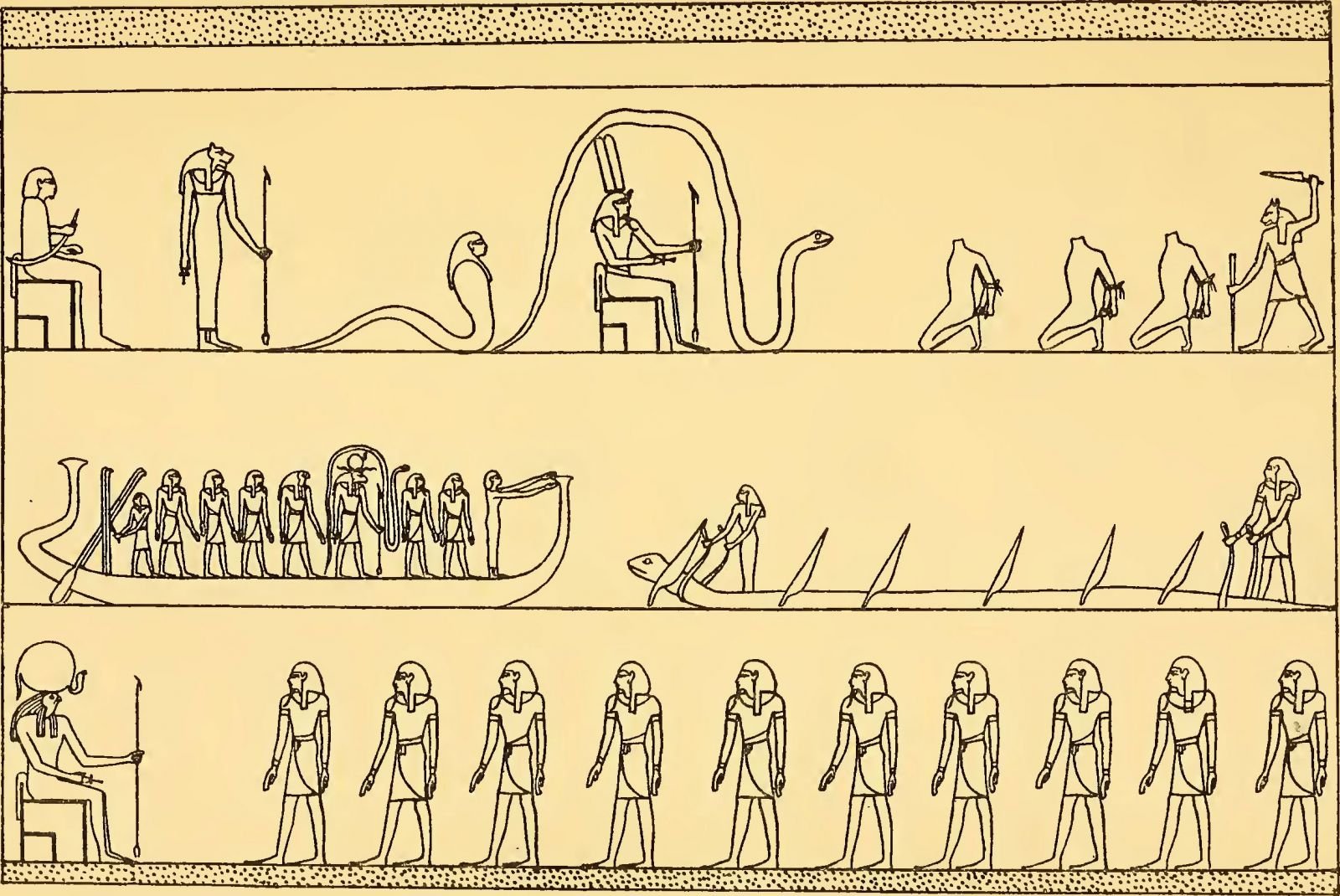

The Seventh Hour, which is called Khesef-hȧa-ḥeseq-Neḥa-ḥrȧ, takes us into the region of the Ṭuat which contains the hidden abode of the god Osiris.
The descriptive text says,
“When the majesty of this great god arriveth in the hidden abode (Tepḥet) of Osiris, he addresseth to the gods who are there [suitable] words. This god maketh to himself other forms for this hidden abode, so that he may turn back the way for Āpep by means of the magical words of Isis, and the magical words of Ser,
.
The name of the pylon of this city through which the god journeyeth is ‘Gate of Osiris’ (); and the name of the city is Tepḥet-shetat (
). This great god passeth over the hidden way of Ȧmentet in his boat which is endowed with magical powers, and he journeyeth over it when there is no stream in it, and when there are none to tow him.
He performeth this by means of the words of power of Isis and of Ser, and by means of the mighty words of power which proceed from his own mouth, and in this region of the Ṭuat he inflicteth with the knife wounds upon Āpep, whose place is in heaven.”
The man who shall make a picture of the things which are to the north of the hidden house of the Ṭuat shall find it of great benefit to him both in heaven and on earth ; and he who knows it shall be among the spirits near Rā, and he who recites the words of Isis and Ser shall repulse Āpep in ȧmentet, and he shall have a place on the boat of Rā both in heaven and upon earth. The man who knows not this picture shall never be able to repulse the serpent Neḥa-ḥrȧ.
The text continues,
“The shallows of the land of Neḥa-ḥrȧ are 450 cubits long, and it is filled with his folds, but over one portion thereof this great god journeyeth not when he travelleth to the hidden abode of Osiris, for he journeyeth through this city under the form of the god Meḥen, () .
Neḥa-ḥrȧ shall never drink the water of him that knoweth this, and the soul which knoweth it shall never be given over to the violence of the gods who are in this Circle ; and the crocodile Āb-she () shall never eat the soul of him that knoweth it.”
From what is said above we see that the boat of Rā has arrived at a shallow place in the celestial stream where there is not enough water to float the boat, or even to allow it to be towed ; moreover, the serpent Neḥa-ḥrȧ opposes the advance of the god. In this difficulty Isis, the great enchantress, enters the boat, and standing in the bows utters the words which make it proceed on its way.
image right: The Seventh Hour of the Night.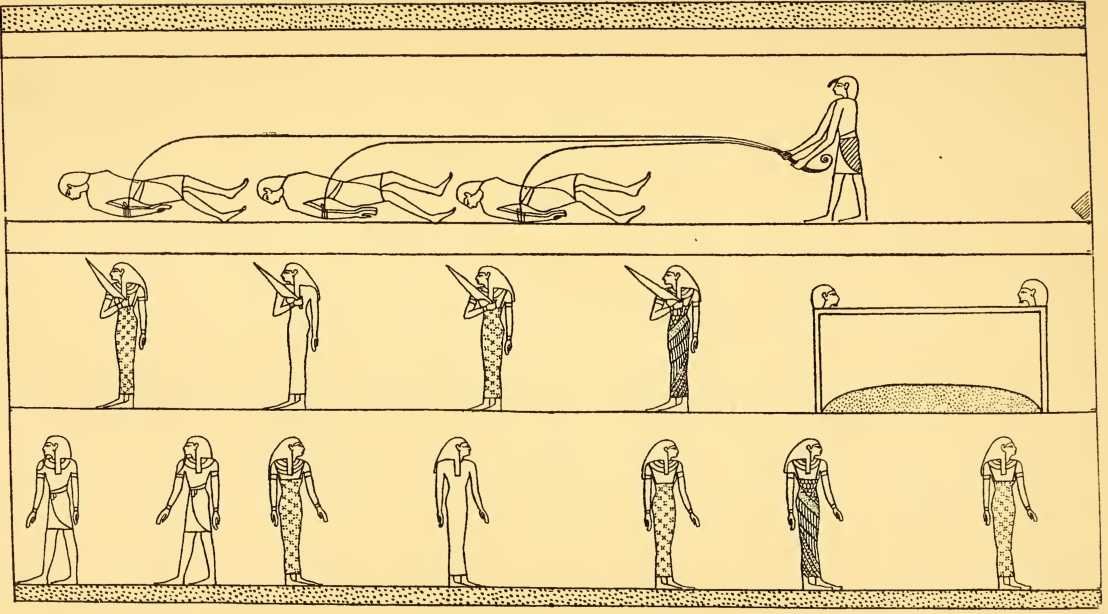

Neḥa-ḥrȧ, as we see from the illustrated edition of the hour, is seized by Serqet and Ḥer-ṭesu-f,  , and held in bonds, and is transfixed to the ground by six knives ; thus Rā, with the serpent Meḥen over him in the form of a canopy, moves on without let or hindrance. Behind the monster serpent stand four goddesses, each armed with a huge knife, whose duty it is to guard the tombs of the four forms of Osiris ; the names of the four goddesses are :—
, and held in bonds, and is transfixed to the ground by six knives ; thus Rā, with the serpent Meḥen over him in the form of a canopy, moves on without let or hindrance. Behind the monster serpent stand four goddesses, each armed with a huge knife, whose duty it is to guard the tombs of the four forms of Osiris ; the names of the four goddesses are :—
 , and held in bonds, and is transfixed to the ground by six knives ; thus Rā, with the serpent Meḥen over him in the form of a canopy, moves on without let or hindrance. Behind the monster serpent stand four goddesses, each armed with a huge knife, whose duty it is to guard the tombs of the four forms of Osiris ; the names of the four goddesses are :—
, and held in bonds, and is transfixed to the ground by six knives ; thus Rā, with the serpent Meḥen over him in the form of a canopy, moves on without let or hindrance. Behind the monster serpent stand four goddesses, each armed with a huge knife, whose duty it is to guard the tombs of the four forms of Osiris ; the names of the four goddesses are :—
Ṭemṭith, ,
,
 ,
,
Ṭenith, ,
,
 ,
,
Nȧkith, ,
,
 ,
,
and Ḥetemitet, .
.
 .
.
Their duty was to drive away the enemies of Rā, and to hack in pieces with their awful knives the fiend Āpep every day. The four tombs of Osiris are rectangular buildings, and inside each is a bed or small mound of sand whereunder lie the dead souls of the god, which are known by the names Tern, Kheperȧ, Rā, and Osiris. At each end of each tomb is a human head, which is said to come forth from the tombs whenever it hears the voice of Rā, and after he has passed “they eat their own forms,” i.e., the heads disappear from sight.
It was, no doubt, a custom in predynastic times to slay slaves at the graves of kings and nobles, just as in many parts of the world it has been the custom to kill human beings and to lay their bodies beneath the foundations of buildings which were to be erected in order that the souls of the slaughtered might protect them and keep away evil spirits. The human heads on the tombs of Osiris probably represent a tradition that, when Osiris was buried, human sacrifices were offered at his tomb for this or for some similar purpose.
This view has been well discussed by M. Lefébure, who has done so much to illustrate the religious and funeral customs of the ancient Egyptians, and some allusion to it is probably made by Horapollo,who says that when they wanted to represent φυλακτήριον they were wont to draw two human heads, one male and the other female, that of the male looking inwards, and that of the female outwards. These heads would keep away the attack of any evil spirit, even if no inscription was placed with them.
image right: The Seventh Hour of the Night.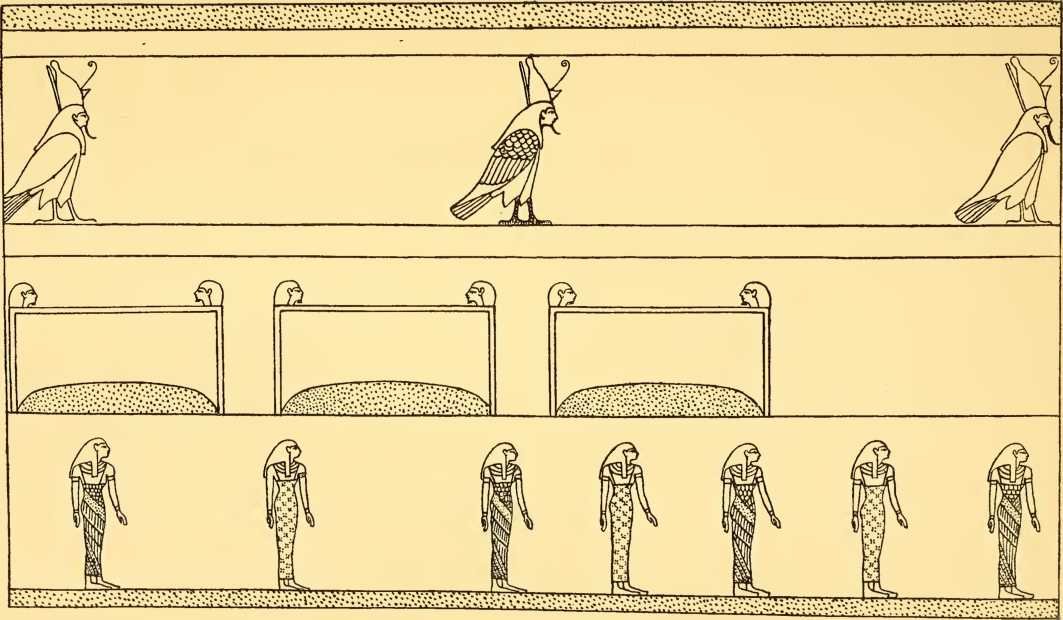

The other illustrations of this hour show us the god Ȧf-Asȧr,  , i.e., “Flesh of Osiris,” seated under a canopy made by the body of a form of the serpent Meḥen called Ānkh-ȧru-tchefau,
, i.e., “Flesh of Osiris,” seated under a canopy made by the body of a form of the serpent Meḥen called Ānkh-ȧru-tchefau,  , with the human-headed serpent Ānkhtith,
, with the human-headed serpent Ānkhtith,  , and the lion-headed goddess Ḥekenth,
, and the lion-headed goddess Ḥekenth,  , behind him; a little further behind is the god Shepes,
, behind him; a little further behind is the god Shepes,  , a form of Thoth.
, a form of Thoth.
 , i.e., “Flesh of Osiris,” seated under a canopy made by the body of a form of the serpent Meḥen called Ānkh-ȧru-tchefau,
, i.e., “Flesh of Osiris,” seated under a canopy made by the body of a form of the serpent Meḥen called Ānkh-ȧru-tchefau,  , with the human-headed serpent Ānkhtith,
, with the human-headed serpent Ānkhtith,  , and the lion-headed goddess Ḥekenth,
, and the lion-headed goddess Ḥekenth,  , behind him; a little further behind is the god Shepes,
, behind him; a little further behind is the god Shepes,  , a form of Thoth.
, a form of Thoth.
Before the god kneel three figures, whose heads have been cut off by a cat-headed god, and lying on the ground are three beings who have been fettered by the god Ȧnku,  , these represent the enemies of Osiris whose souls have been plucked out, and whose shadows have been hacked in pieces because they rebelled against the lord of the Ṭuat. Before these are three human-headed hawks wearing double crowns, and they represent the souls of the “living;” and on a serpent near is seated on a throne the god Ȧf-Tem,
, these represent the enemies of Osiris whose souls have been plucked out, and whose shadows have been hacked in pieces because they rebelled against the lord of the Ṭuat. Before these are three human-headed hawks wearing double crowns, and they represent the souls of the “living;” and on a serpent near is seated on a throne the god Ȧf-Tem,  , i.e., “Flesh of Tem.”
, i.e., “Flesh of Tem.”
 , these represent the enemies of Osiris whose souls have been plucked out, and whose shadows have been hacked in pieces because they rebelled against the lord of the Ṭuat. Before these are three human-headed hawks wearing double crowns, and they represent the souls of the “living;” and on a serpent near is seated on a throne the god Ȧf-Tem,
, these represent the enemies of Osiris whose souls have been plucked out, and whose shadows have been hacked in pieces because they rebelled against the lord of the Ṭuat. Before these are three human-headed hawks wearing double crowns, and they represent the souls of the “living;” and on a serpent near is seated on a throne the god Ȧf-Tem,  , i.e., “Flesh of Tem.”
, i.e., “Flesh of Tem.”
image right: The Seventh Hour of the Night.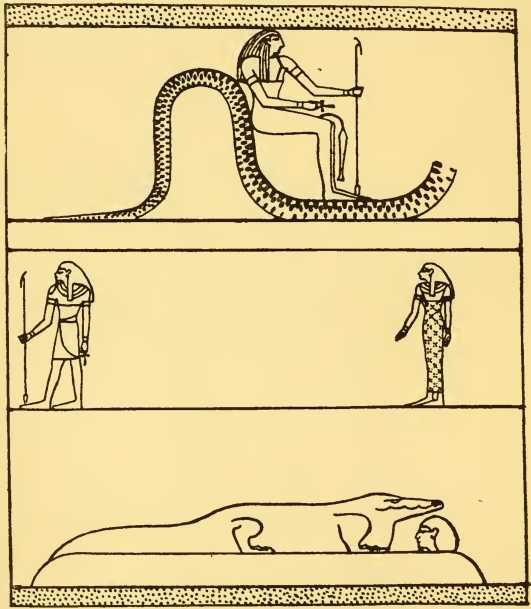

Among the other gods in this hour is “Horus on his throne,” and before him are a company of gods who have been joined to their stars, and the goddesses of the twelve hours. Facing these companies is the crocodile “Āb-shā-ȧm-Ṭuat,”  , who acts as guardian of the tomb of Osiris and of what is in it.
, who acts as guardian of the tomb of Osiris and of what is in it.
 , who acts as guardian of the tomb of Osiris and of what is in it.
, who acts as guardian of the tomb of Osiris and of what is in it.
When Rā passes by the crocodile, which is described as “Osiris, the Eye of Rā,” this beast is fascinated and made helpless by the words so long as the god is speaking to him, and the dead Osiris, who is in the ground under the crocodile, puts up his head that he also may look at the Sun-god ; the followers of Osiris also seize the opportunity of gazing upon Rā, and do so without risk of being devoured by the monster which is temporarily enchanted.
Eighth Hour of the Night
image right: The Eight Hour of the Night.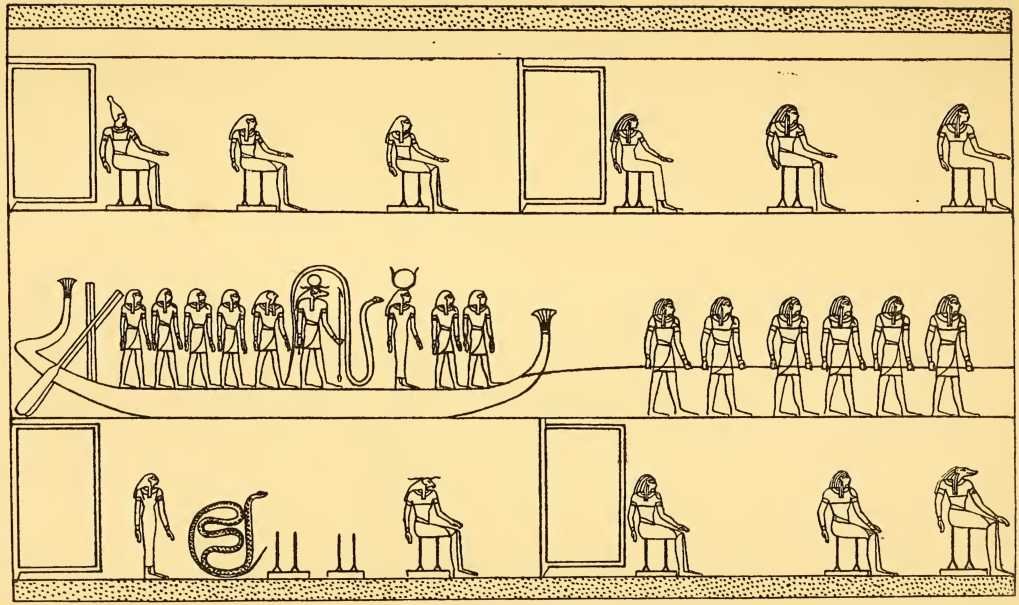

The Eighth Hour, which is called Nebt Ushau, brings us into a very interesting division of the Ṭuat; the name of its pylonis Āḥā-en-urṭ-nef,  , and the name of the city is Ṭebat-neteru-s,
, and the name of the city is Ṭebat-neteru-s,  . Rā passes through this division in his boat under the protection of Meḥen, and its gods tow him at the command of this mighty snake ; he sees all the gods in their various Circles, and those “who are on their sand,” and he addresses words to them.
. Rā passes through this division in his boat under the protection of Meḥen, and its gods tow him at the command of this mighty snake ; he sees all the gods in their various Circles, and those “who are on their sand,” and he addresses words to them.
 , and the name of the city is Ṭebat-neteru-s,
, and the name of the city is Ṭebat-neteru-s,  . Rā passes through this division in his boat under the protection of Meḥen, and its gods tow him at the command of this mighty snake ; he sees all the gods in their various Circles, and those “who are on their sand,” and he addresses words to them.
. Rā passes through this division in his boat under the protection of Meḥen, and its gods tow him at the command of this mighty snake ; he sees all the gods in their various Circles, and those “who are on their sand,” and he addresses words to them.
They come out of their secret abodes when the god passes by, and the doors thereof open of their own accord. In this Hour only gods and spirits who have been mummified and buried with appropriate rites are to be found, and, though dead, they quickly come to life again at the words of Rā, who exhorts them to put an end to all the enemies of his who are to be found in that region.
image right: The Eight Hour of the Night.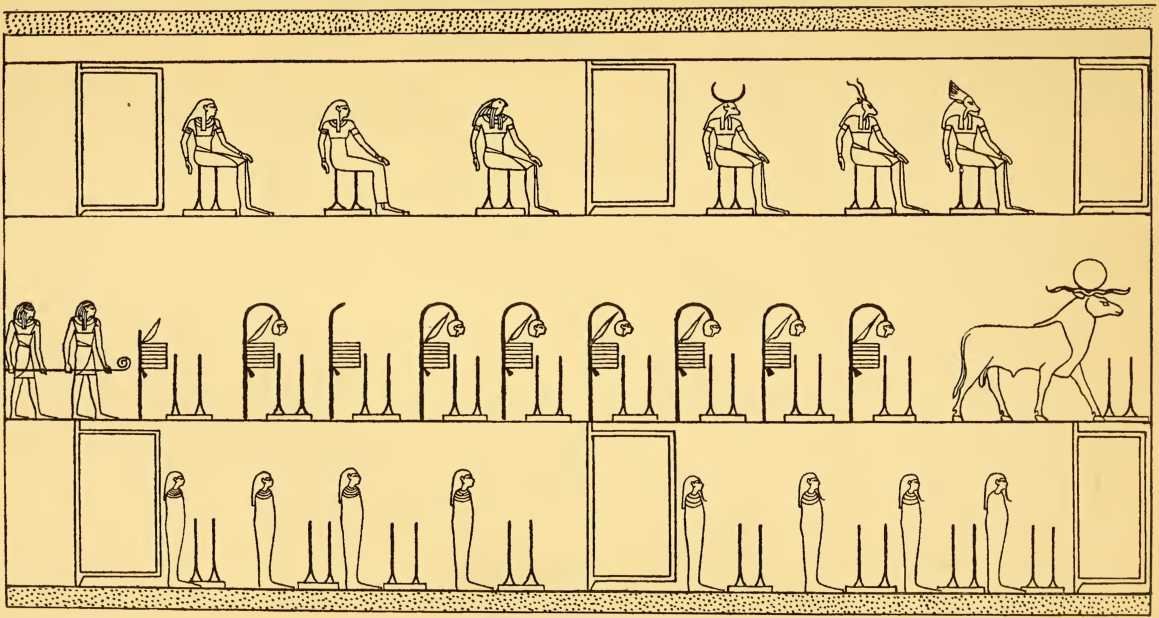

The illustrated edition of the Hour shows us the boat of the god being towed along, and in front of it are nine large signs, the forms of which are based upon the hieroglyphic character Shesu or shemsu, i,e., “follower” or “servant.” From the top of seven of these is suspended a human head, which shows that we are actually dealing with beings who are in the following of Osiris, and before each is the hieroglyphic for “linen,”
Shesu or shemsu, i,e., “follower” or “servant.” From the top of seven of these is suspended a human head, which shows that we are actually dealing with beings who are in the following of Osiris, and before each is the hieroglyphic for “linen,” .
.
 Shesu or shemsu, i,e., “follower” or “servant.” From the top of seven of these is suspended a human head, which shows that we are actually dealing with beings who are in the following of Osiris, and before each is the hieroglyphic for “linen,”
Shesu or shemsu, i,e., “follower” or “servant.” From the top of seven of these is suspended a human head, which shows that we are actually dealing with beings who are in the following of Osiris, and before each is the hieroglyphic for “linen,” .
.
These nine remarkable objects represent beings who have been mummified in the manner prescribed by Horus, and who are suitably provided with funeral bandages; they are described as beings whose whole life is in their heads, and when Rā calls to them by their names they immediately seize his enemies everywhere and cut off their heads with their knives.
Before these are the four forms of the god Ṭa-thenen, , which are depicted as rams and are
, which are depicted as rams and are
 , which are depicted as rams and are
, which are depicted as rams and are- described as
- “form one,”
 ,
, - “form two,”
 ,
, - “form three,”
 ,
, - and “form four,”
 .
.
image right: The Eighth Hour of the Night.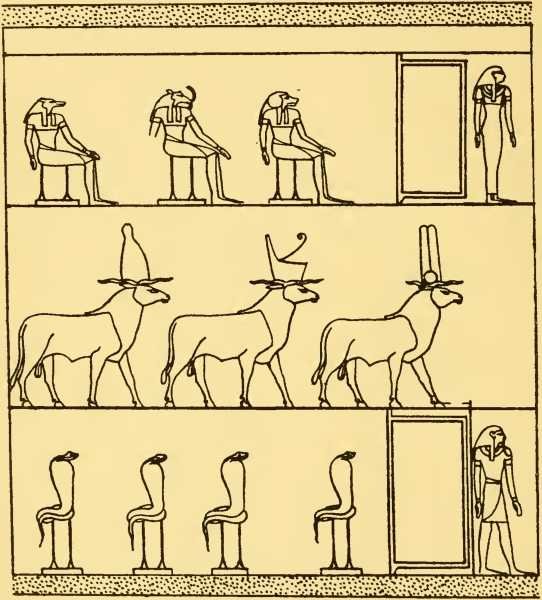

On each side of the way by which Rā journeys are five Circles.
1) The door of the first Circle, Sesheta, is called Ṭes-neb-ṭerer. . . .  , and shuts in the images of Tem, Kheperȧ, and Shu ; when Rā speaks to them they answer in a voice which resembles the humming of bees.
, and shuts in the images of Tem, Kheperȧ, and Shu ; when Rā speaks to them they answer in a voice which resembles the humming of bees.
 , and shuts in the images of Tem, Kheperȧ, and Shu ; when Rā speaks to them they answer in a voice which resembles the humming of bees.
, and shuts in the images of Tem, Kheperȧ, and Shu ; when Rā speaks to them they answer in a voice which resembles the humming of bees.
2) The door of the second Circle, Ṭuat,  , is called Ṭes-āḥā-Ta-thenen,
, is called Ṭes-āḥā-Ta-thenen,  , and shuts in the images of Tefnut, Seb, and Nut; when Rā speaks to them they answer in a voice which resembles that of weeping women.
, and shuts in the images of Tefnut, Seb, and Nut; when Rā speaks to them they answer in a voice which resembles that of weeping women.
 , is called Ṭes-āḥā-Ta-thenen,
, is called Ṭes-āḥā-Ta-thenen,  , and shuts in the images of Tefnut, Seb, and Nut; when Rā speaks to them they answer in a voice which resembles that of weeping women.
, and shuts in the images of Tefnut, Seb, and Nut; when Rā speaks to them they answer in a voice which resembles that of weeping women.
3) The door of the third Circle, Ȧs-neteru,  , is called Ṭes-khem-baiu,
, is called Ṭes-khem-baiu,  , and shuts in the images of Osiris, Isis, and Horus ; when Rā speaks to them they answer in a voice which resembles that of men who moan.
, and shuts in the images of Osiris, Isis, and Horus ; when Rā speaks to them they answer in a voice which resembles that of men who moan.
 , is called Ṭes-khem-baiu,
, is called Ṭes-khem-baiu,  , and shuts in the images of Osiris, Isis, and Horus ; when Rā speaks to them they answer in a voice which resembles that of men who moan.
, and shuts in the images of Osiris, Isis, and Horus ; when Rā speaks to them they answer in a voice which resembles that of men who moan.
4) The door of the fourth Circle, Ȧaḳebi,  , is called Ṭes-sheta-em-theḥen-neteru,
, is called Ṭes-sheta-em-theḥen-neteru,  , and shuts in the images of Ka-Ȧmentet,
, and shuts in the images of Ka-Ȧmentet,  , Ba-neteru,
, Ba-neteru,  , and Rem-neteru,
, and Rem-neteru,  ; when Rā speaks to them they answer in a voice which is like that of bulls and men when they make lamentation.
; when Rā speaks to them they answer in a voice which is like that of bulls and men when they make lamentation.
 , is called Ṭes-sheta-em-theḥen-neteru,
, is called Ṭes-sheta-em-theḥen-neteru,  , and shuts in the images of Ka-Ȧmentet,
, and shuts in the images of Ka-Ȧmentet,  , Ba-neteru,
, Ba-neteru,  , and Rem-neteru,
, and Rem-neteru,  ; when Rā speaks to them they answer in a voice which is like that of bulls and men when they make lamentation.
; when Rā speaks to them they answer in a voice which is like that of bulls and men when they make lamentation.
5) The door of the fifth Circle, Nebt-semu-nefu,  , is called Ṭes-sma-kekui,
, is called Ṭes-sma-kekui,  , and shuts in the images of Khatri,
, and shuts in the images of Khatri,  , and Ȧrānbfi,
, and Ȧrānbfi,  ; when Rā speaks to them they answer in a voice which is like unto that of him that maketh supplication in terror. These five Circles are shut in by a door called Ṭes-khaibit-ṭuatiu,
; when Rā speaks to them they answer in a voice which is like unto that of him that maketh supplication in terror. These five Circles are shut in by a door called Ṭes-khaibit-ṭuatiu,  .
.
 , is called Ṭes-sma-kekui,
, is called Ṭes-sma-kekui,  , and shuts in the images of Khatri,
, and shuts in the images of Khatri,  , and Ȧrānbfi,
, and Ȧrānbfi,  ; when Rā speaks to them they answer in a voice which is like unto that of him that maketh supplication in terror. These five Circles are shut in by a door called Ṭes-khaibit-ṭuatiu,
; when Rā speaks to them they answer in a voice which is like unto that of him that maketh supplication in terror. These five Circles are shut in by a door called Ṭes-khaibit-ṭuatiu,  .
.
6) The door of the sixth Circle is called Ṭes-ermen-ta, and shuts in some divine beings whose attributes are not yet all clearly defined; when Rā speaks to them they answer in a voice which is like that of male cats when they mew.
and shuts in some divine beings whose attributes are not yet all clearly defined; when Rā speaks to them they answer in a voice which is like that of male cats when they mew.
 and shuts in some divine beings whose attributes are not yet all clearly defined; when Rā speaks to them they answer in a voice which is like that of male cats when they mew.
and shuts in some divine beings whose attributes are not yet all clearly defined; when Rā speaks to them they answer in a voice which is like that of male cats when they mew.
7) The door of the seventh Circle, Ḥetemet-khemiu,  , is called Ṭes-Rā-khefti-f,
, is called Ṭes-Rā-khefti-f,  , and shuts in Nut, Ta, and Sebeq-ḥrȧ,
, and shuts in Nut, Ta, and Sebeq-ḥrȧ,  ; when Rā speaks to them they answer in a voice which is like the roar of the living.
; when Rā speaks to them they answer in a voice which is like the roar of the living.
 , is called Ṭes-Rā-khefti-f,
, is called Ṭes-Rā-khefti-f,  , and shuts in Nut, Ta, and Sebeq-ḥrȧ,
, and shuts in Nut, Ta, and Sebeq-ḥrȧ,  ; when Rā speaks to them they answer in a voice which is like the roar of the living.
; when Rā speaks to them they answer in a voice which is like the roar of the living.
8) The door of the eighth Circle, Ḥap-semu-s,  , is called Ṭes-sekhem-ȧru,
, is called Ṭes-sekhem-ȧru,  , and shuts in four gods; when Rā speaks to them they answer in a voice which is like the shouts of war heard in the battle of Nu.
, and shuts in four gods; when Rā speaks to them they answer in a voice which is like the shouts of war heard in the battle of Nu.
 , is called Ṭes-sekhem-ȧru,
, is called Ṭes-sekhem-ȧru,  , and shuts in four gods; when Rā speaks to them they answer in a voice which is like the shouts of war heard in the battle of Nu.
, and shuts in four gods; when Rā speaks to them they answer in a voice which is like the shouts of war heard in the battle of Nu.
9) The door of the ninth Circle, Seḥert-baiu-s,  , is called Ṭes-sepṭ-nestu,
, is called Ṭes-sepṭ-nestu,  , and shuts in four gods; when Rā speaks to them they answer in a voice which is like that of the cry of the divine hawk of Horus.
, and shuts in four gods; when Rā speaks to them they answer in a voice which is like that of the cry of the divine hawk of Horus.
 , is called Ṭes-sepṭ-nestu,
, is called Ṭes-sepṭ-nestu,  , and shuts in four gods; when Rā speaks to them they answer in a voice which is like that of the cry of the divine hawk of Horus.
, and shuts in four gods; when Rā speaks to them they answer in a voice which is like that of the cry of the divine hawk of Horus.
10) The door of the tenth Circle, Āāt-setekau,  , is called Ṭes-khu,
, is called Ṭes-khu,  , and shuts in four gods in the form of uraei who rest upon
, and shuts in four gods in the form of uraei who rest upon ; when Ra speaks to them they answer in a voice which is like the twittering and chattering of water-fowl on a lake. The last five Circles are shut in by a door called Ṭes-am-mit-em-sheta-f,
; when Ra speaks to them they answer in a voice which is like the twittering and chattering of water-fowl on a lake. The last five Circles are shut in by a door called Ṭes-am-mit-em-sheta-f, .
.
 , is called Ṭes-khu,
, is called Ṭes-khu,  , and shuts in four gods in the form of uraei who rest upon
, and shuts in four gods in the form of uraei who rest upon ; when Ra speaks to them they answer in a voice which is like the twittering and chattering of water-fowl on a lake. The last five Circles are shut in by a door called Ṭes-am-mit-em-sheta-f,
; when Ra speaks to them they answer in a voice which is like the twittering and chattering of water-fowl on a lake. The last five Circles are shut in by a door called Ṭes-am-mit-em-sheta-f, .
.Ninth Hour of the Night
image right: The Ninth Hour of the Night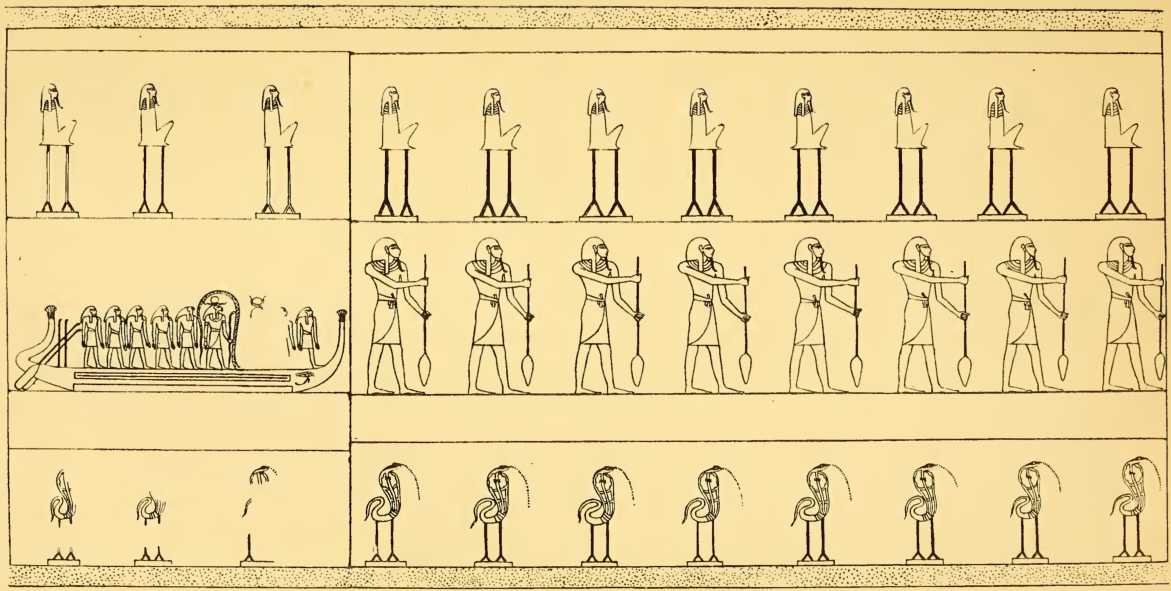

The Ninth Hour, which is called Ṭuatet-māket-neb-s, brings us into a country which is called the “hidden Circle of Ȧmentet”; the name of the city is Bes-ȧru,
 ,and the name of its pylon is Sa-Aḳeb,
,and the name of its pylon is Sa-Aḳeb,  .
.

 ,and the name of its pylon is Sa-Aḳeb,
,and the name of its pylon is Sa-Aḳeb,  .
.“When the great god arriveth in this Circle he addresseth from his boat the gods who are therein, and the sailors who are in his boat are content with this city.”
The man who shall make a copy of the scenes of this Hour, and shall know the names of the gods and their places in Ȧmentet shall attain to a position in Ȧmentet, and he shall stand up in the presence of the lord of affairs and shall enjoy the power of making what he says to come to pass with the divine assessors,  , on the day of reckoning up accounts by Per-āa (Pharaoh).
, on the day of reckoning up accounts by Per-āa (Pharaoh).
 , on the day of reckoning up accounts by Per-āa (Pharaoh).
, on the day of reckoning up accounts by Per-āa (Pharaoh).
image right: The Ninth Hour of the Night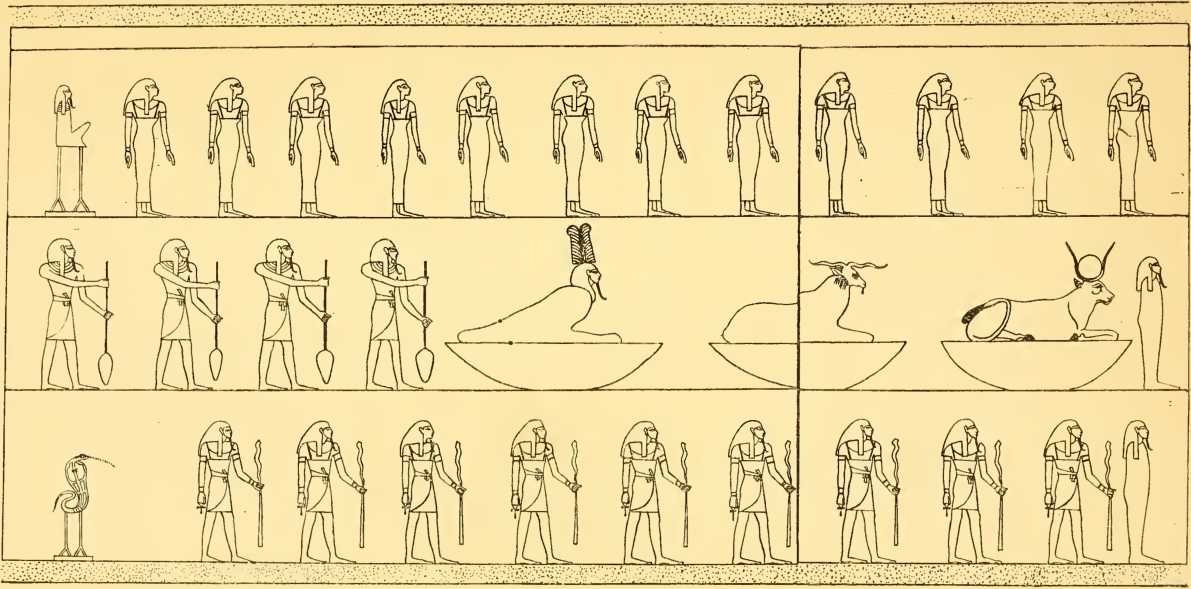

The illustrated edition of this Hour shows us the boat of the god travelling on as before, and in front of it are twelve divine rowers, each with his paddle; among these are
- Khenu,
 ,
, - Ȧkhem-sek-f,
 ,
, - Ȧkhem-urṭ-f,
 ,
, - Ȧkhem-ḥemi-f,
 ,
, - Ȧkhem-khemes-f,
 ,
, - Khen-unnut-f,
 ,
, - Ḥāpti-ta-f,
 ,
, - Ḥetep-uȧa,
 ,
, - Neter-neteru,
 .
. - Tcha-Ṭuat,
 ,
, - and Ṭepi,
 .
.
The duty of these sailors is not only to row, but also to throw water with their paddles upon the spirits who stand on each bank of the river whereon the god sails, and they have to lead the soul of Rā to the place where he will reanimate the disk.
Before these sailors, resting on baskets, are the three gods who give abundant offerings,
- Muti-khenti-Ṭuat,
 ,
, - Nesti-khenti-Ṭuat,
 ,
, - and Nebt-āu-khent-Ṭuat,

 .
.
On the right the boat of Rā passes twelve gods, each seated on , and twelve goddesses ; these last are said to breathe after he has saluted them, and after they have heard his voice, and their duty is to utter words of power wherewith they are to surround the hidden soul, and thereby to cause life and strength to rise up in Osiris.
, and twelve goddesses ; these last are said to breathe after he has saluted them, and after they have heard his voice, and their duty is to utter words of power wherewith they are to surround the hidden soul, and thereby to cause life and strength to rise up in Osiris.
 , and twelve goddesses ; these last are said to breathe after he has saluted them, and after they have heard his voice, and their duty is to utter words of power wherewith they are to surround the hidden soul, and thereby to cause life and strength to rise up in Osiris.
, and twelve goddesses ; these last are said to breathe after he has saluted them, and after they have heard his voice, and their duty is to utter words of power wherewith they are to surround the hidden soul, and thereby to cause life and strength to rise up in Osiris.
The names of these are :—
- Nehata,
 ,
, - Ṭeba,
 ,
, - Ariti,
 ,
, - Menkhet,
 ,
, - Hebs,
 ,
, - Nebti,
 ,
, - Ȧsti-neter,
 ,
, - Ȧsti-paut,
 ,
, - Ḥetemet-khu,
 ,
, - Neb-pāt,
 ,
, - Ṭemṭu,
 ,
, - Men-ā,
 ,
, - Perit,
 ,
, - Shemat-khu,
 ,
, - Nebt-shāt,
 ,
, - Nebt-shef-shefet,
 ,
, - Ȧat-ȧaṭet,
 ,
, - Nebt-seṭau,
 ,
, - Ḥent-nut-s,
 ,
, - Nebt-mȧt,
 ,
, - Ṭesert-ȧnt,
 ,
, - Āat-khu,

 ,
, - Sekhet-meṭu,
 ,
, - Netert-en-khentet-Rā,
 .
.
On the left are twelve uraei, each of whom rests on , and sends out fire through his mouth ; they are said to kindle the fire for the god who is in the Ṭuat with the fire which is in their mouths, and when the god has passed on his way they eat up the fire which they poured forth before Rā went by. The object of the fire was, of course, to show light on his path.
, and sends out fire through his mouth ; they are said to kindle the fire for the god who is in the Ṭuat with the fire which is in their mouths, and when the god has passed on his way they eat up the fire which they poured forth before Rā went by. The object of the fire was, of course, to show light on his path.
 , and sends out fire through his mouth ; they are said to kindle the fire for the god who is in the Ṭuat with the fire which is in their mouths, and when the god has passed on his way they eat up the fire which they poured forth before Rā went by. The object of the fire was, of course, to show light on his path.
, and sends out fire through his mouth ; they are said to kindle the fire for the god who is in the Ṭuat with the fire which is in their mouths, and when the god has passed on his way they eat up the fire which they poured forth before Rā went by. The object of the fire was, of course, to show light on his path.
Before these uraei come the nine gods of cultivation and of husbandry, who are under the direction of a god in mummified form; these nine are the sehhtiu, , or “field-labourers,” of the god Ḥer-she-ṭuati,
, or “field-labourers,” of the god Ḥer-she-ṭuati, , their leader, and they perforin all the works connected with the ploughing and watering of the fields
, their leader, and they perforin all the works connected with the ploughing and watering of the fields
 , or “field-labourers,” of the god Ḥer-she-ṭuati,
, or “field-labourers,” of the god Ḥer-she-ṭuati, , their leader, and they perforin all the works connected with the ploughing and watering of the fields
, their leader, and they perforin all the works connected with the ploughing and watering of the fieldsTenth Hour of the Night
image right: The Tenth Hour of the Night.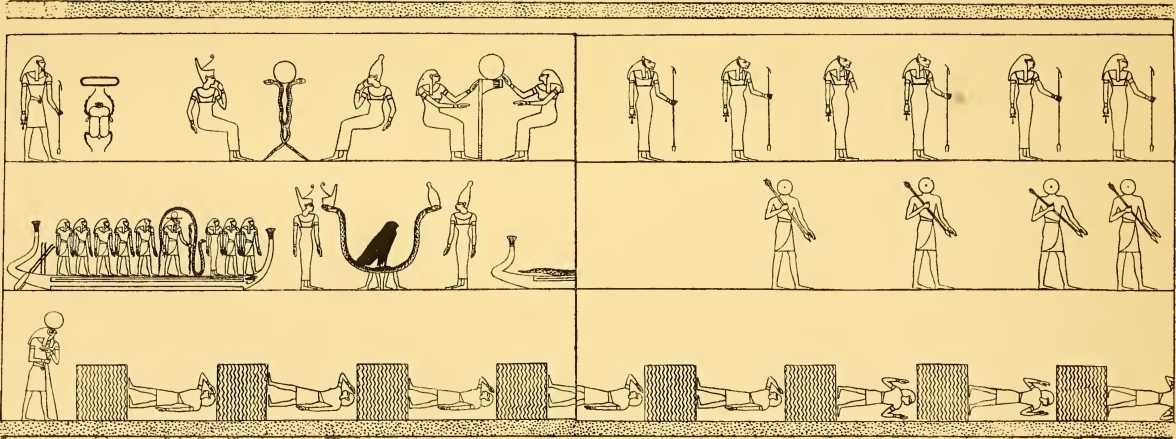

The Tenth Hour, which is called Ṭenṭit-uḥesqet-khaṭ-ȧb, brings Rā in his boat to the city called Metchet-qat-uṭebu,  , with its pylon called Āa-kheperu-mes-ȧru,
, with its pylon called Āa-kheperu-mes-ȧru,  .
.
 , with its pylon called Āa-kheperu-mes-ȧru,
, with its pylon called Āa-kheperu-mes-ȧru,  .
.
The boat of the sun travels on as before, but Rā again holds a serpent in his hand after the manner of a staff. Immediately in front is the serpent Thes-ḥrȧu, , with a head at each end of his body ; on one head is the white crown, and on the other the red crown ; he has two pairs of human legs, one pair turned towards the right, and the other pair towards the left.
, with a head at each end of his body ; on one head is the white crown, and on the other the red crown ; he has two pairs of human legs, one pair turned towards the right, and the other pair towards the left.
 , with a head at each end of his body ; on one head is the white crown, and on the other the red crown ; he has two pairs of human legs, one pair turned towards the right, and the other pair towards the left.
, with a head at each end of his body ; on one head is the white crown, and on the other the red crown ; he has two pairs of human legs, one pair turned towards the right, and the other pair towards the left.
His body is bent in the form of a pair of horns, and in the curve stands Khent-Ḥeru, , in the form of a black hawk ; on the left is the goddess of the north, Neith, with her two bows,
, in the form of a black hawk ; on the left is the goddess of the north, Neith, with her two bows, , and on the right is the goddess Ḥert-ermen,
, and on the right is the goddess Ḥert-ermen,  . Next comes a boat containing the serpent Ānkh-ta, and before it are three groups, each containing four gods.
. Next comes a boat containing the serpent Ānkh-ta, and before it are three groups, each containing four gods.
 , in the form of a black hawk ; on the left is the goddess of the north, Neith, with her two bows,
, in the form of a black hawk ; on the left is the goddess of the north, Neith, with her two bows, , and on the right is the goddess Ḥert-ermen,
, and on the right is the goddess Ḥert-ermen,  . Next comes a boat containing the serpent Ānkh-ta, and before it are three groups, each containing four gods.
. Next comes a boat containing the serpent Ānkh-ta, and before it are three groups, each containing four gods.
The gods of the first group have solar disks for heads, and are armed with arrows, and are called
- Ṭeptherȧ,
 ,
, - Sheserȧ,
 ,
, - Ṭemau,
 ,
, - and Uṭu,
 .
.
The gods of the second group carry each a javelin, and are called
- Setu,
 ,
, - Rāu,
 ,
, - Khesfu,
 ,
, - and Nekenu,
 ;
;
and the gods of the third group carry each a bow, and are called
- Pesthi,
 ,
, - Shemerthi,
 ,
, - Ṭhesu,
 ,
, - and Khā-ā,
 .
.
image right: The Tenth Hour of the Night.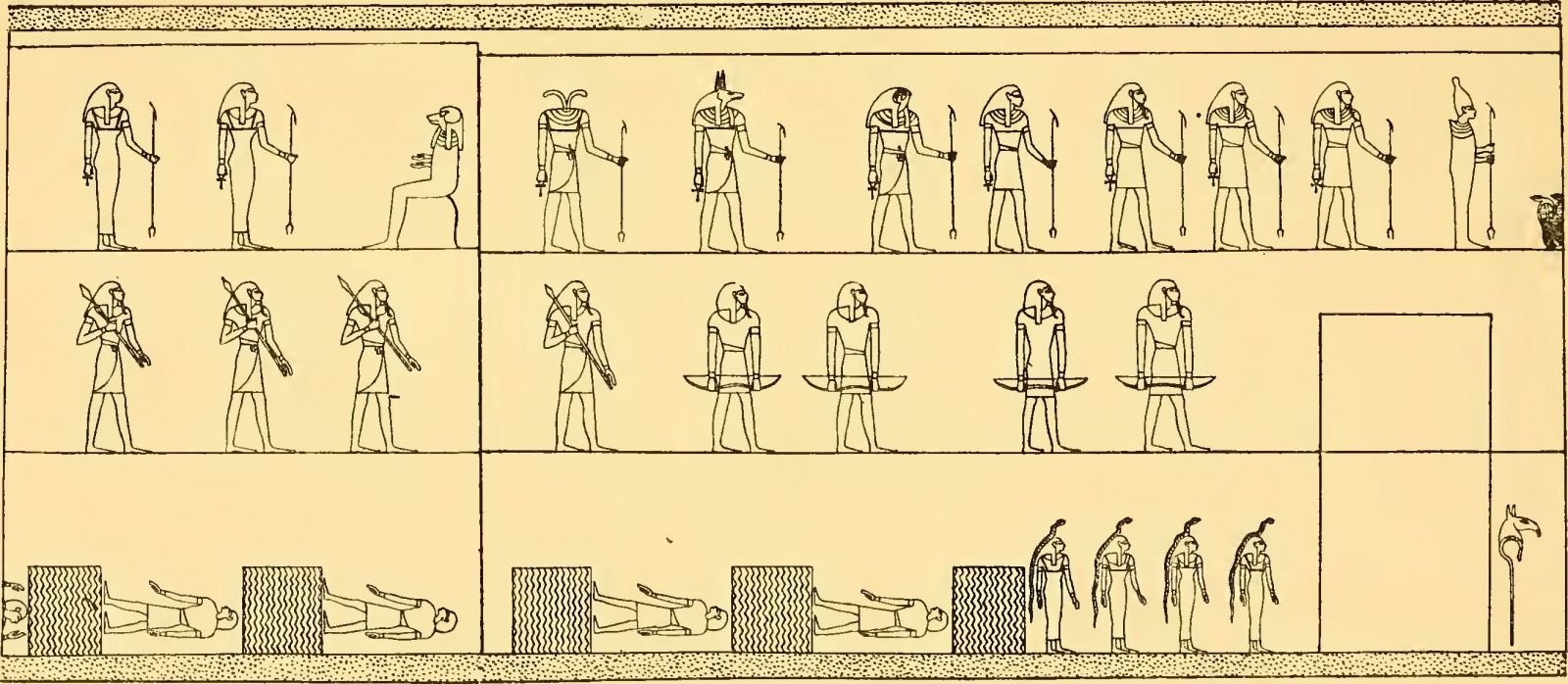

All these gods accompany Rā as he goes towards the east, and they slay all his enemies who live in the darkness, and wreak special vengeance on the serpent Neḥa-ḥrȧ; they escort the god to the very limits of the Hour, and form part of his train in the eastern part of the sky.
The name of the region traversed by Ra in this Hour is Ȧḳert,  . As the boat of Rā passes the god sees the “living beetle,”
. As the boat of Rā passes the god sees the “living beetle,”  , born in the presence of the god P-ānkhi,
, born in the presence of the god P-ānkhi,  , and sees how he pushes before him his zone,
, and sees how he pushes before him his zone, .
.
 . As the boat of Rā passes the god sees the “living beetle,”
. As the boat of Rā passes the god sees the “living beetle,”  , born in the presence of the god P-ānkhi,
, born in the presence of the god P-ānkhi,  , and sees how he pushes before him his zone,
, and sees how he pushes before him his zone, .
.
Next we have the two serpents, Menenui, , standing on their tails, and holding on their bent necks a solar disk ; and two seated personifications of the South and North ; and the two goddesses, Netheth,
, standing on their tails, and holding on their bent necks a solar disk ; and two seated personifications of the South and North ; and the two goddesses, Netheth,  , and Kenȧt,
, and Kenȧt, , one of whom supports the hatchet, and the other the solar disk, which rests upon it,
, one of whom supports the hatchet, and the other the solar disk, which rests upon it, .
.
 , standing on their tails, and holding on their bent necks a solar disk ; and two seated personifications of the South and North ; and the two goddesses, Netheth,
, standing on their tails, and holding on their bent necks a solar disk ; and two seated personifications of the South and North ; and the two goddesses, Netheth,  , and Kenȧt,
, and Kenȧt, , one of whom supports the hatchet, and the other the solar disk, which rests upon it,
, one of whom supports the hatchet, and the other the solar disk, which rests upon it, .
.
From the serpents go forth two goddesses, those of the East and West; and from the axe, called Sefṭit, , go forth the goddesses of the East and West also ; i.e., these goddesses are the souls of the serpents and of the axe, which come forth to look upon the Sun-god, and as soon as he has passed they return into their material bodies.
, go forth the goddesses of the East and West also ; i.e., these goddesses are the souls of the serpents and of the axe, which come forth to look upon the Sun-god, and as soon as he has passed they return into their material bodies.
 , go forth the goddesses of the East and West also ; i.e., these goddesses are the souls of the serpents and of the axe, which come forth to look upon the Sun-god, and as soon as he has passed they return into their material bodies.
, go forth the goddesses of the East and West also ; i.e., these goddesses are the souls of the serpents and of the axe, which come forth to look upon the Sun-god, and as soon as he has passed they return into their material bodies.
Next Rā sees eight goddesses advancing to a seated dog-headed god, who presents to them the Eye of Horus, , and their duty is to see that it is in good condition, and to take care of it and protect it, so that it may shine daily.
, and their duty is to see that it is in good condition, and to take care of it and protect it, so that it may shine daily.
 , and their duty is to see that it is in good condition, and to take care of it and protect it, so that it may shine daily.
, and their duty is to see that it is in good condition, and to take care of it and protect it, so that it may shine daily.
Besides these there come the eight gods called
- Ermenui,
 ,
, - Neb-āqet,
 ,
, - Ṭua-khu,
 ,
, - Ḥer-she-taiu,
 ,
, - Sem-Ḥeru,
 ,
, - Ṭua-Ḥeru,
 ,
, - Khenti-ȧst-f,
 ,
, - and Khenti-ment,
 ;
;
the duty of these gods, who lived by the breath of the great god, was to wreck the bodies and scatter the swathings of the enemies of Rā. On his left hand Rā passed in his journey through this Hour Horus, and twelve beings who dive and swim and perform evolutions in tanks of water.
These are said to beat the water in their attempts to recover their breath, and Rā calls upon them to fill themselves with the water of the celestial Nile, and promises that their members shall not suffer corruption, and that their bodies shall not perish ; he decrees that they shall be masters of their own arms in their water because they are the denizens of Nu, and that their souls shall live.
Beyond these are four goddesses, each with a serpent hanging down her back with its head above her own, and with them is a standard surmounted by the head of Set, . This god was the guardian of the Tenth Hour, and when Rā was about to pass from it into the eastern part of the sky, Set was believed to rouse himself and to make the journey with him. The four goddesses “who lived by their heads,” shed light on the path of Rā.
. This god was the guardian of the Tenth Hour, and when Rā was about to pass from it into the eastern part of the sky, Set was believed to rouse himself and to make the journey with him. The four goddesses “who lived by their heads,” shed light on the path of Rā.
 . This god was the guardian of the Tenth Hour, and when Rā was about to pass from it into the eastern part of the sky, Set was believed to rouse himself and to make the journey with him. The four goddesses “who lived by their heads,” shed light on the path of Rā.
. This god was the guardian of the Tenth Hour, and when Rā was about to pass from it into the eastern part of the sky, Set was believed to rouse himself and to make the journey with him. The four goddesses “who lived by their heads,” shed light on the path of Rā.Eleventh Hour of the Night
image right: The Eleventh Hour of the Night.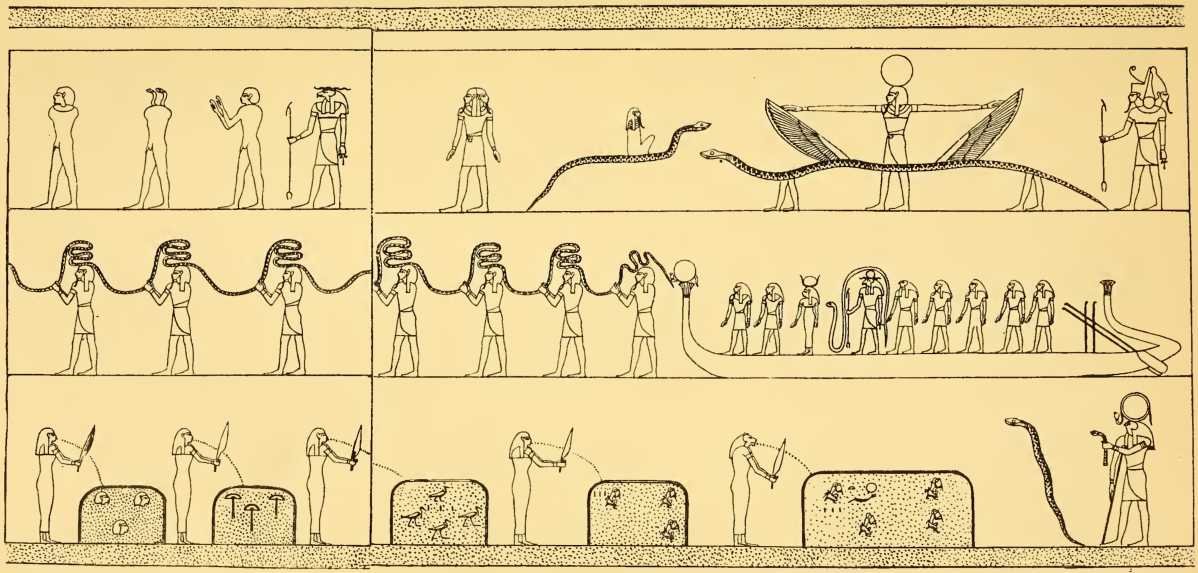

The Eleventh Hour, which is called Sebuit-nebt-uȧa-khesfet-sebȧu-em-pert-f, brings us to a city called Re-qerert-ȧpt-khaṭ, , with a pylon bearing the name of Sekhen-ṭuatiu,
, with a pylon bearing the name of Sekhen-ṭuatiu, ; the object of the texts and the illustrations which accompany it was to enable the spirits of the dead to become participators with the gods, and to provide them with such things as were necessary for their equipment both in heaven and upon earth.
; the object of the texts and the illustrations which accompany it was to enable the spirits of the dead to become participators with the gods, and to provide them with such things as were necessary for their equipment both in heaven and upon earth.
 , with a pylon bearing the name of Sekhen-ṭuatiu,
, with a pylon bearing the name of Sekhen-ṭuatiu, ; the object of the texts and the illustrations which accompany it was to enable the spirits of the dead to become participators with the gods, and to provide them with such things as were necessary for their equipment both in heaven and upon earth.
; the object of the texts and the illustrations which accompany it was to enable the spirits of the dead to become participators with the gods, and to provide them with such things as were necessary for their equipment both in heaven and upon earth.
Rā stands as usual in his boat, but he has changed the serpent which he held in his hand as a sceptre for the ordinary sceptre,, and on the bows of the boat we see a solar disk, surrounded by a serpent; the name of this disk is
a serpent; the name of this disk is or
or , Pesṭu or Pesṭet, and it is probably connected with some well-known star which rose heliacally at certain seasons of the year.
, Pesṭu or Pesṭet, and it is probably connected with some well-known star which rose heliacally at certain seasons of the year.
 a serpent; the name of this disk is
a serpent; the name of this disk is or
or , Pesṭu or Pesṭet, and it is probably connected with some well-known star which rose heliacally at certain seasons of the year.
, Pesṭu or Pesṭet, and it is probably connected with some well-known star which rose heliacally at certain seasons of the year.
The duty of the disk was to guide the boat of the great god along the paths which led to that part of the Ṭuat, at the end of the Eleventh Hour, where the darkness faded away ; the texts call the darkness at this point keku ḳesḳu, , i.e., the opposite of the keku samui,
, i.e., the opposite of the keku samui, , or the thick, solid darkness which filled the greater part of the Ṭuat.
, or the thick, solid darkness which filled the greater part of the Ṭuat.
 , i.e., the opposite of the keku samui,
, i.e., the opposite of the keku samui, , or the thick, solid darkness which filled the greater part of the Ṭuat.
, or the thick, solid darkness which filled the greater part of the Ṭuat.
Before the boat of Rā are twelve gods, who carry upon their heads the serpent Mehen to the eastern part of the sky; their names are:—
- Fa,
 ,
, - Ermenu,
 ,
, - Athpi,
 ,
, - Neṭru,
 ,
, - Shepu,
 ,
, - Reṭā,
 ,
, - Amu,
 .
. - Ama,
 ,
, - Sheṭu,
 ,
, - Sekhenu,
 ,
, - Semsem,
 ,
, - and Meḥni,
 .
.
Before these are :—
- A uraeus wearing the crown of the North and a human head ; and,
- A uraeus from the back of which emerges the white crown, with a human head on each side of it.
The first of these is called Sem-shet,  , and the second Sem-Nebt-ḥet,
, and the second Sem-Nebt-ḥet,  ; the human heads on the white crown only come forth when Rā is passing by, and when he has departed they disappear.
; the human heads on the white crown only come forth when Rā is passing by, and when he has departed they disappear.
 , and the second Sem-Nebt-ḥet,
, and the second Sem-Nebt-ḥet,  ; the human heads on the white crown only come forth when Rā is passing by, and when he has departed they disappear.
; the human heads on the white crown only come forth when Rā is passing by, and when he has departed they disappear.
Next we have figures of the four forms of the goddess Neith, two of them wearing the white crown, and two the red ; they are called Neith the fecundator,  , in allusion to the belief that this goddess begat herself, Neith of the red crown,
, in allusion to the belief that this goddess begat herself, Neith of the red crown,  , Neith of the white crown,
, Neith of the white crown,  , and Neith the child,
, and Neith the child, ; these goddesses came into being as soon as they heard the voice of Rā, and their duty was to guard the gate of Saïs,
; these goddesses came into being as soon as they heard the voice of Rā, and their duty was to guard the gate of Saïs, , the unknown, the unseen, the invisible,
, the unknown, the unseen, the invisible, .
.
 , in allusion to the belief that this goddess begat herself, Neith of the red crown,
, in allusion to the belief that this goddess begat herself, Neith of the red crown,  , Neith of the white crown,
, Neith of the white crown,  , and Neith the child,
, and Neith the child, ; these goddesses came into being as soon as they heard the voice of Rā, and their duty was to guard the gate of Saïs,
; these goddesses came into being as soon as they heard the voice of Rā, and their duty was to guard the gate of Saïs, , the unknown, the unseen, the invisible,
, the unknown, the unseen, the invisible, .
.
This Circle of the Ṭuat through which the god travels to appear in the mountain of the sunrise contains many wonderful beings, and it is said to
“swallow always the forms therein in the presence of the god who knoweth,, who is in this city, and afterwards it giveth them for the births of those who are to come into being on this earth.”
Among these are:—
A god with the solar disk for a head ; from it project two human heads, one wearing  , and the other
, and the other  . He is called Āper-ḥrȧ-neb-tchetta,
. He is called Āper-ḥrȧ-neb-tchetta,  , and stands facing a god having two heads, but without crowns, whose name is Ṭepui,
, and stands facing a god having two heads, but without crowns, whose name is Ṭepui,  . In the space between we see a serpent provided with a pair of wings and four human legs and feet, facing the serpent Sheṭu,
. In the space between we see a serpent provided with a pair of wings and four human legs and feet, facing the serpent Sheṭu,  , upon the back of which is seated a god ; the heads of both serpents are among a number of stars.
, upon the back of which is seated a god ; the heads of both serpents are among a number of stars.
 , and the other
, and the other  . He is called Āper-ḥrȧ-neb-tchetta,
. He is called Āper-ḥrȧ-neb-tchetta,  , and stands facing a god having two heads, but without crowns, whose name is Ṭepui,
, and stands facing a god having two heads, but without crowns, whose name is Ṭepui,  . In the space between we see a serpent provided with a pair of wings and four human legs and feet, facing the serpent Sheṭu,
. In the space between we see a serpent provided with a pair of wings and four human legs and feet, facing the serpent Sheṭu,  , upon the back of which is seated a god ; the heads of both serpents are among a number of stars.
, upon the back of which is seated a god ; the heads of both serpents are among a number of stars.
Standing by the side of the winged serpent, which is called Tchet-s,  , is a god called Petrȧ,
, is a god called Petrȧ,  , with his arms stretched out in such a way as to keep the wings wide apart; he has on his head a disk, and his neck is between the double Utchat,
, with his arms stretched out in such a way as to keep the wings wide apart; he has on his head a disk, and his neck is between the double Utchat,  .
.
 , is a god called Petrȧ,
, is a god called Petrȧ,  , with his arms stretched out in such a way as to keep the wings wide apart; he has on his head a disk, and his neck is between the double Utchat,
, with his arms stretched out in such a way as to keep the wings wide apart; he has on his head a disk, and his neck is between the double Utchat,  .
.
image right: The Eleventh Hour of the Night.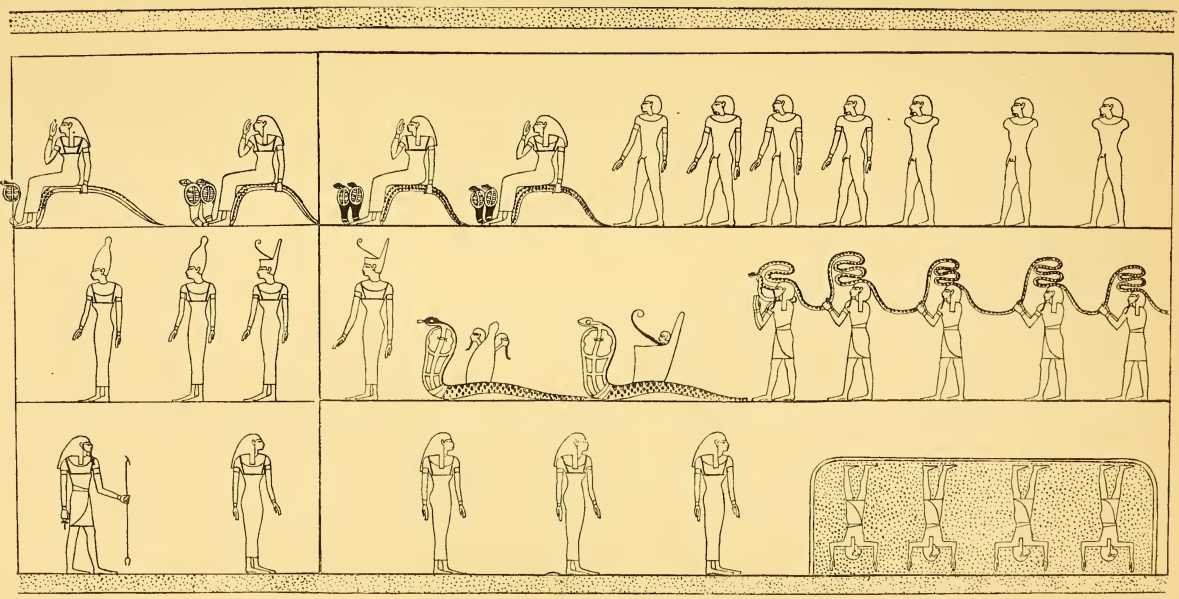

The descriptive text says that the god with a disk and two heads is “he who stands, , by Rā,” and that he never leaves his place in the Ṭuat. The god who stands by the winged serpent is Temu, who springs out of the reptile’s back when Rā addresses it; but as soon as the words cease Temu disappears into the serpent.
, by Rā,” and that he never leaves his place in the Ṭuat. The god who stands by the winged serpent is Temu, who springs out of the reptile’s back when Rā addresses it; but as soon as the words cease Temu disappears into the serpent.
 , by Rā,” and that he never leaves his place in the Ṭuat. The god who stands by the winged serpent is Temu, who springs out of the reptile’s back when Rā addresses it; but as soon as the words cease Temu disappears into the serpent.
, by Rā,” and that he never leaves his place in the Ṭuat. The god who stands by the winged serpent is Temu, who springs out of the reptile’s back when Rā addresses it; but as soon as the words cease Temu disappears into the serpent.
The second serpent is the constellation Sheṭu, i.e., the Tortoise, and its soul appears in human form on its back as soon as Rā addresses it, but when the words have ceased like Temu it disappears into its body. The duty of Sheṭu was to “emit life for Rā every day.”
Before these march Khnemu and ten gods, five of whom have no arms ; from the neck of one of these project the heads of two serpents. From the descriptive text we learn that the souls of these gods lived on the hidden light of Rā ; that the breath of his mouth gave them life, and that their souls fed upon the provisions which were stored in his boat; their chief duty was to be with and in attendance upon the god.
Besides these gods we also have in this Hour four goddesses, each of whom sits upon the bodies of two uraei, which are bent upwards in such a way as to form a seat; the heads of each pair of uraei are reared up in front of the knees of the goddess, who is sitting on their backs, and whose feet rest upon their necks.
Each goddess has her right hand raised as if to hide her face, and with her left she grasps the body of one of the uraei. It is possible that the uraei are only four in number, and that they are two-headed; the goddesses are called Nebt-ānkhiu, . Nebt-khu,
. Nebt-khu, , Nert,
, Nert, , and Ḥent (?)-neteru,
, and Ḥent (?)-neteru, .
.
 . Nebt-khu,
. Nebt-khu, , Nert,
, Nert, , and Ḥent (?)-neteru,
, and Ḥent (?)-neteru, .
.
The descriptive text says that the arms of these beings are on earth, and their feet in the thick darkness, and as long as the god is speaking to them they utter cries and acclaim him ; they never move from their places, and their souls live upon the voices of the uraei which go forth from their feet daily.
When the shadows depart the winds which arise in the Tu at are diverted from the faces of the four goddesses by their hands, which they hold up. In this statement we seem to have an allusion to the keen, fresh wind of dawn with which all travellers in the desert are well acquainted, and which usually blows about one hour before sunrise.
In the region on the left hand side of Rā we see how punishment is inflicted upon the enemies of Rā, and in it we have a country of blazing fire. At one end stands Horus with a disk, surrounded by a uraeus, upon his head, holding in his left hand a boomerang, one end of which terminates in the head of a serpent; the idea here suggested is that the weapon held by the god is a real serpent, which when thrown at an enemy will suddenly attach itself to his body after the manner of the vicious uraeus.
The right arm of Horus rests on a staff wherewith the god usually supports himself, and before him rears itself a huge serpent called “Set of millions of years,”  , the duty of which was to devour any of the enemies of Rā, i.e., the dead, who succeeded in making their escape from the fires of the country of the Eleventh Hour. In front of these were the five awful chambers, or pits in the sky, which were filled with the red-hot materials of blazing fires, and employed to consume the enemies of Rā.
, the duty of which was to devour any of the enemies of Rā, i.e., the dead, who succeeded in making their escape from the fires of the country of the Eleventh Hour. In front of these were the five awful chambers, or pits in the sky, which were filled with the red-hot materials of blazing fires, and employed to consume the enemies of Rā.
 , the duty of which was to devour any of the enemies of Rā, i.e., the dead, who succeeded in making their escape from the fires of the country of the Eleventh Hour. In front of these were the five awful chambers, or pits in the sky, which were filled with the red-hot materials of blazing fires, and employed to consume the enemies of Rā.
, the duty of which was to devour any of the enemies of Rā, i.e., the dead, who succeeded in making their escape from the fires of the country of the Eleventh Hour. In front of these were the five awful chambers, or pits in the sky, which were filled with the red-hot materials of blazing fires, and employed to consume the enemies of Rā.
1) The first chamber or pit, Ḥaṭet, , was filled with the bodies of fiends who were dashing out their own brains with axes,
, was filled with the bodies of fiends who were dashing out their own brains with axes,  , and was under the charge of a lion-headed goddess, called Ḥert-Ketit-s,
, and was under the charge of a lion-headed goddess, called Ḥert-Ketit-s, , who stood by its side and belched fire into it through her mouth ; when the fire had done its work on the wretched creatures they were hacked to pieces by the huge knife which she held in both her hands.
, who stood by its side and belched fire into it through her mouth ; when the fire had done its work on the wretched creatures they were hacked to pieces by the huge knife which she held in both her hands.
 , was filled with the bodies of fiends who were dashing out their own brains with axes,
, was filled with the bodies of fiends who were dashing out their own brains with axes,  , and was under the charge of a lion-headed goddess, called Ḥert-Ketit-s,
, and was under the charge of a lion-headed goddess, called Ḥert-Ketit-s, , who stood by its side and belched fire into it through her mouth ; when the fire had done its work on the wretched creatures they were hacked to pieces by the huge knife which she held in both her hands.
, who stood by its side and belched fire into it through her mouth ; when the fire had done its work on the wretched creatures they were hacked to pieces by the huge knife which she held in both her hands.
2) The second chamber or pit was also filled with the bodies of fiends, and was under the charge of a woman called Ḥert-Ḥānṭuȧ, , who spat fire upon them and who was armed with a monster knife.
, who spat fire upon them and who was armed with a monster knife.
 , who spat fire upon them and who was armed with a monster knife.
, who spat fire upon them and who was armed with a monster knife.
3) The third chamber or pit was filled with the souls, , of the fiends, and was under the charge of a woman called Ḥert-Nekeniṭ,
, of the fiends, and was under the charge of a woman called Ḥert-Nekeniṭ, , who spat fire upon them and who was similarly armed.
, who spat fire upon them and who was similarly armed.
 , of the fiends, and was under the charge of a woman called Ḥert-Nekeniṭ,
, of the fiends, and was under the charge of a woman called Ḥert-Nekeniṭ, , who spat fire upon them and who was similarly armed.
, who spat fire upon them and who was similarly armed.
4) The fourth and fifth chambers, which were under the charge of similar women, called Ḥert-Nemmȧt-set,  , and Ḥert-sefu-s,
, and Ḥert-sefu-s,  , contained the shadows,
, contained the shadows,  , and heads,
, and heads,  , of the damned. Passing by these chambers we come to the “Valley of those who are cast down headlong,”
, of the damned. Passing by these chambers we come to the “Valley of those who are cast down headlong,”  , which is represented by a large hollow wherein four men are standing on their heads,
, which is represented by a large hollow wherein four men are standing on their heads,  ; next to this are four goddesses of the desert, each of whom has upon her head the emblem of desert; their names are
; next to this are four goddesses of the desert, each of whom has upon her head the emblem of desert; their names are
 , and Ḥert-sefu-s,
, and Ḥert-sefu-s,  , contained the shadows,
, contained the shadows,  , and heads,
, and heads,  , of the damned. Passing by these chambers we come to the “Valley of those who are cast down headlong,”
, of the damned. Passing by these chambers we come to the “Valley of those who are cast down headlong,”  , which is represented by a large hollow wherein four men are standing on their heads,
, which is represented by a large hollow wherein four men are standing on their heads,  ; next to this are four goddesses of the desert, each of whom has upon her head the emblem of desert; their names are
; next to this are four goddesses of the desert, each of whom has upon her head the emblem of desert; their names are- Pesi,
 ,
, - Rekḥit,
 ,
, - Ḥer-shā-s,
 ,
, - and Sait,
 .
.
Each name has a meaning something like “fiery,” and refers to the goddesses in their character of mistresses of the blazing desert.
Finally, behind these comes the god Ḥer-ut-f, , who was in some way connected with the embalming of the dead. The descriptive text which accompanies these scenes makes the great god Rā command
, who was in some way connected with the embalming of the dead. The descriptive text which accompanies these scenes makes the great god Rā command
 , who was in some way connected with the embalming of the dead. The descriptive text which accompanies these scenes makes the great god Rā command
, who was in some way connected with the embalming of the dead. The descriptive text which accompanies these scenes makes the great god Rā command“his father Osiris to hack in pieces the bodies of the enemies and of the dead who are cast down headlong.”
Then, addressing the enemies themselves, he tells them that when his father Osiris hath smitten them for destruction, and hath cut in pieces their spirits and souls, and hath rent asunder their shadows, and hath cut off their heads in such a way that existence in the future will be impossible for them, they will be cast down headlong into burning furnaces from which there is neither escape nor deliverance, and Set the everlasting snake will drive his flames against them, and the Lady of furnaces, and the Lady of fiery pits, and the Lady of slaughtering blocks, and the Lady of swords, will drive against them the flames which come forth from their mouths, that they will hack them in pieces in such wise that the wretched beings will never again see those who live upon the earth.
The slaughter of the enemies is ordered to be performed by Horus, the god of those who are in the Ṭuat, and it is curious to note that the gods his companions are said to live upon the voices of the enemies who are slain, and on the shrieks and cries of the souls and shadows which are cast down into the blazing, fiery pits.
Twelfth Hour of the Night
The Twelfth Hour, Maa-nefert-Rā, brings the god Rā into the Circle which is on the confines of thick darkness, and to a city called Khepert-kekui-khāāt-mest,  , with its pylon called Then-neteru,
, with its pylon called Then-neteru,  . In this region the god is born under the form of Kheperȧ,
. In this region the god is born under the form of Kheperȧ, 
 , and Nu,
, and Nu,  , and Nut,
, and Nut, , Hehu,
, Hehu,  , and Hehut,
, and Hehut,  , come into the Circle when he is born, and when he goeth forth from the Ṭuat and resteth in the Mānṭit,
, come into the Circle when he is born, and when he goeth forth from the Ṭuat and resteth in the Mānṭit,  , boat, and when he riseth on the body of Nut.
, boat, and when he riseth on the body of Nut.
 , with its pylon called Then-neteru,
, with its pylon called Then-neteru,  . In this region the god is born under the form of Kheperȧ,
. In this region the god is born under the form of Kheperȧ, 
 , and Nu,
, and Nu,  , and Nut,
, and Nut, , Hehu,
, Hehu,  , and Hehut,
, and Hehut,  , come into the Circle when he is born, and when he goeth forth from the Ṭuat and resteth in the Mānṭit,
, come into the Circle when he is born, and when he goeth forth from the Ṭuat and resteth in the Mānṭit,  , boat, and when he riseth on the body of Nut.
, boat, and when he riseth on the body of Nut.
Rā journeys in his boat, as before, but the solar disk which was at the bows in the Eleventh Hour is no longer there, and its place is occupied by the beetle of Kheperȧ, the forerunner of the rising sun. Twelve gods tow the boat, not over a river or over the back of a serpent or serpents, but completely through a serpent; in front the tow-rope is held by the hands of twelve women. This serpent is called Ka-en-Ānkh-neteru, , i.e., “the life of the gods,” and the gods who draw Ȧf, that is to say, Rā, through it are his “loyal servants,”
, i.e., “the life of the gods,” and the gods who draw Ȧf, that is to say, Rā, through it are his “loyal servants,” , Ȧmhhiu.
, Ȧmhhiu.
 , i.e., “the life of the gods,” and the gods who draw Ȧf, that is to say, Rā, through it are his “loyal servants,”
, i.e., “the life of the gods,” and the gods who draw Ȧf, that is to say, Rā, through it are his “loyal servants,” , Ȧmhhiu.
, Ȧmhhiu.
The boat enters the serpent at his tail in deep darkness, and passing through his body emerges through the mouth into the light of day; the god in his boat enters the snake in the form of a dead, old Sun-god, and he comes forth not only alive, but made young again, and appears in the sky under the form of Kheperȧ. The “loyal servants” of Rā are the souls of the blessed which have been so fortunate as to obtain admission into his boat; they were his devout adorers when upon earth, and the reward which they obtain for their fidelity is renewed youth and a new birth upon the earth.
What they are to do upon earth is not made clear, but it is evident that they cannot remain there for an indefinite period, for since their master needs to be re-born daily they also must need re-birth each day. It is doubtful, if we judge by some passages, if they came to the earth at all, and it is far more likely that their enjoyment consisted in journeying about at will through the sky and looking down from some portion of it upon the scenes of their old life than in making hurried visits to the earth daily.
When the boat of Rā has passed through the serpent the twelve women or goddesses, mentioned above, take the rope from the gods and haul it on to the paths of the sky.
The god is accompanied through the Twelfth Hour by:—
- 1. Twelve goddesses, each bearing a serpent on her head and shoulders, and
- 2. Twelve gods, or men, with their hands raised in adoration ; all these are on the right hand side.
Each deity has a name, which is written in front of his or her figure. The uraei of the goddesses are said to proceed from them, and the flames which drive- away Āpep come forth from their mouths. The goddesses travel with the god until he rises on this earth, but after this they return to their places. The duty of the twelve gods is to praise Rā.
On the left of the boat we have the gods
- Nu,
 ,
, - Nuth,
 ,
, - Ḥeḥu,
 ,
, - Ḥeḥut,
 ;
;
these gods are “in their own bodies,” , and they go to Rā in heaven, to receive this great god as he cometh forth to them in the eastern part of heaven daily. They live in their ārrit i.e., hall of the horizon, but their forms,
, and they go to Rā in heaven, to receive this great god as he cometh forth to them in the eastern part of heaven daily. They live in their ārrit i.e., hall of the horizon, but their forms, , of the Ṭuat belong to this Circle.
, of the Ṭuat belong to this Circle.
 , and they go to Rā in heaven, to receive this great god as he cometh forth to them in the eastern part of heaven daily. They live in their ārrit i.e., hall of the horizon, but their forms,
, and they go to Rā in heaven, to receive this great god as he cometh forth to them in the eastern part of heaven daily. They live in their ārrit i.e., hall of the horizon, but their forms, , of the Ṭuat belong to this Circle.
, of the Ṭuat belong to this Circle.
Next we have two human-headed gods,
- a bird-headed god called Nehui,
 ,
, - a god with two birds’ heads called Ni,
 ,
, - the serpent Nesmekhef,
 ,
, - and four human-headed gods;
all these carry paddles on their right shoulders. The duty of the gods is to raise up, , the disk of the sun daily, but the serpent Nesmekhef slaughters the enemies of Rā ; they travel with Rā and receive their spirits,
, the disk of the sun daily, but the serpent Nesmekhef slaughters the enemies of Rā ; they travel with Rā and receive their spirits, , in this Circle. Before these are ten gods, with hands raised in adoration, who are described as the ḥentiu,
, in this Circle. Before these are ten gods, with hands raised in adoration, who are described as the ḥentiu, , of the forms of Osiris, the Governor of the thick darkness,
, of the forms of Osiris, the Governor of the thick darkness,
 , and they say to him,
, and they say to him,
 , the disk of the sun daily, but the serpent Nesmekhef slaughters the enemies of Rā ; they travel with Rā and receive their spirits,
, the disk of the sun daily, but the serpent Nesmekhef slaughters the enemies of Rā ; they travel with Rā and receive their spirits, , in this Circle. Before these are ten gods, with hands raised in adoration, who are described as the ḥentiu,
, in this Circle. Before these are ten gods, with hands raised in adoration, who are described as the ḥentiu, , of the forms of Osiris, the Governor of the thick darkness,
, of the forms of Osiris, the Governor of the thick darkness,
 , and they say to him,
, and they say to him,“Live, thou Governor of thy darkness ! Live, O thou who art great in all things ! Live, O thou Prince of Ȧmentet, Osiris, thou Governor of those who are in Ȧmenti! Mayest thou live, mayest thou live, O thou who art Governor of the Ṭuat, the wind of Rā is to thy nostrils, the breath of Kheperȧ is with thee, thou livest and they live. Hail, Osiris, lord of the living ones ; the gods who are with Osiris are those who were with him at the first time,” etc.

No comments:
Post a Comment